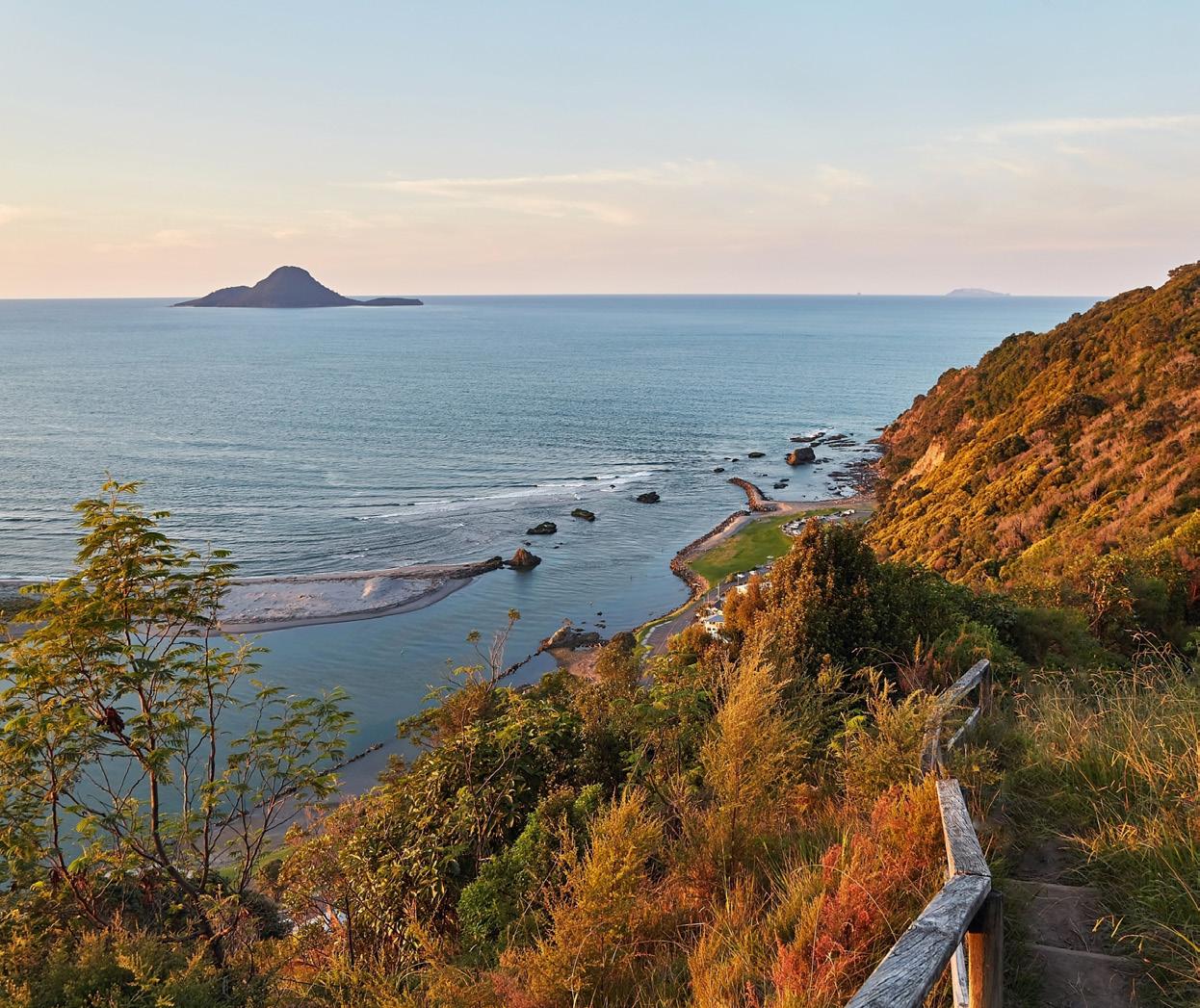
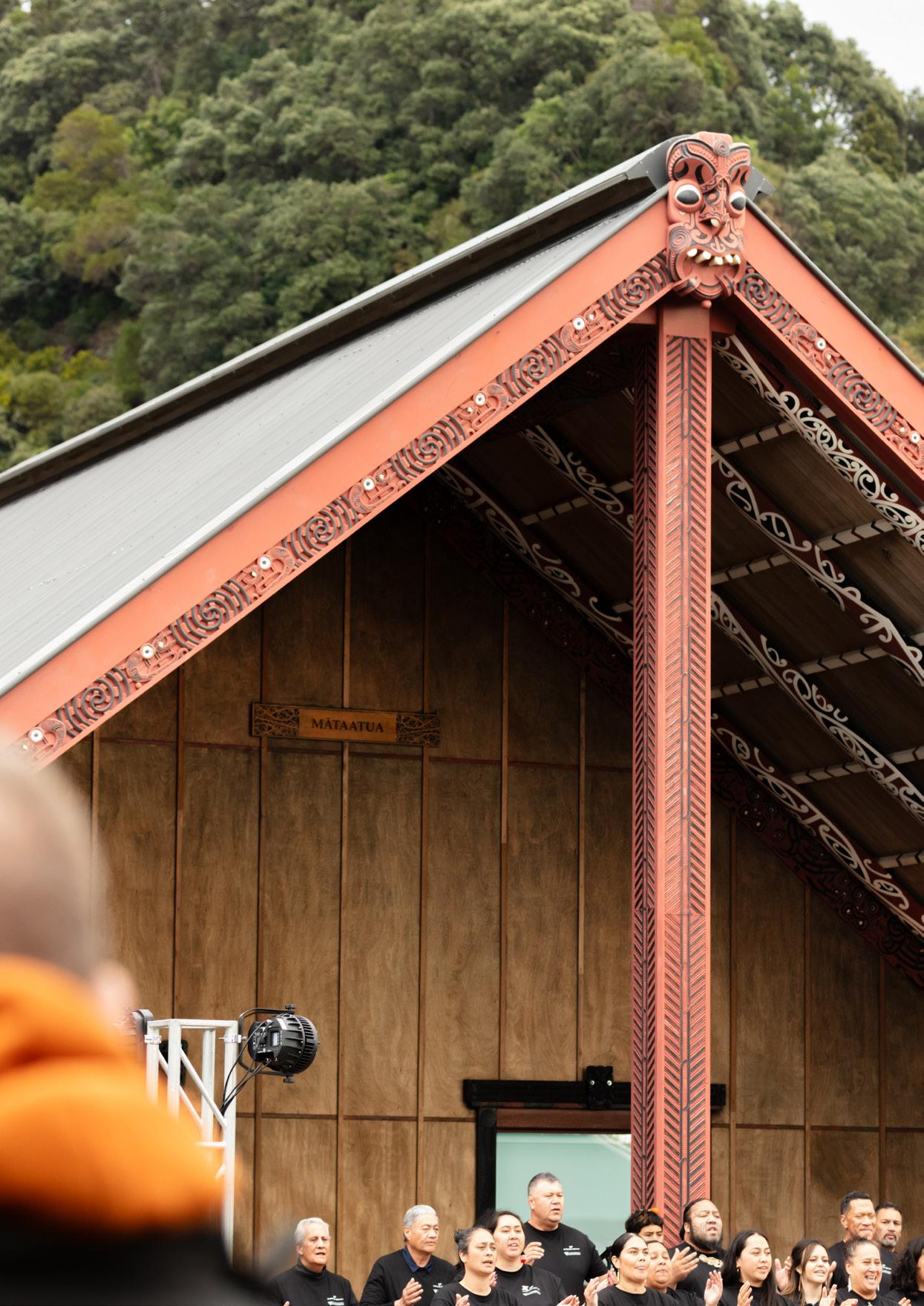
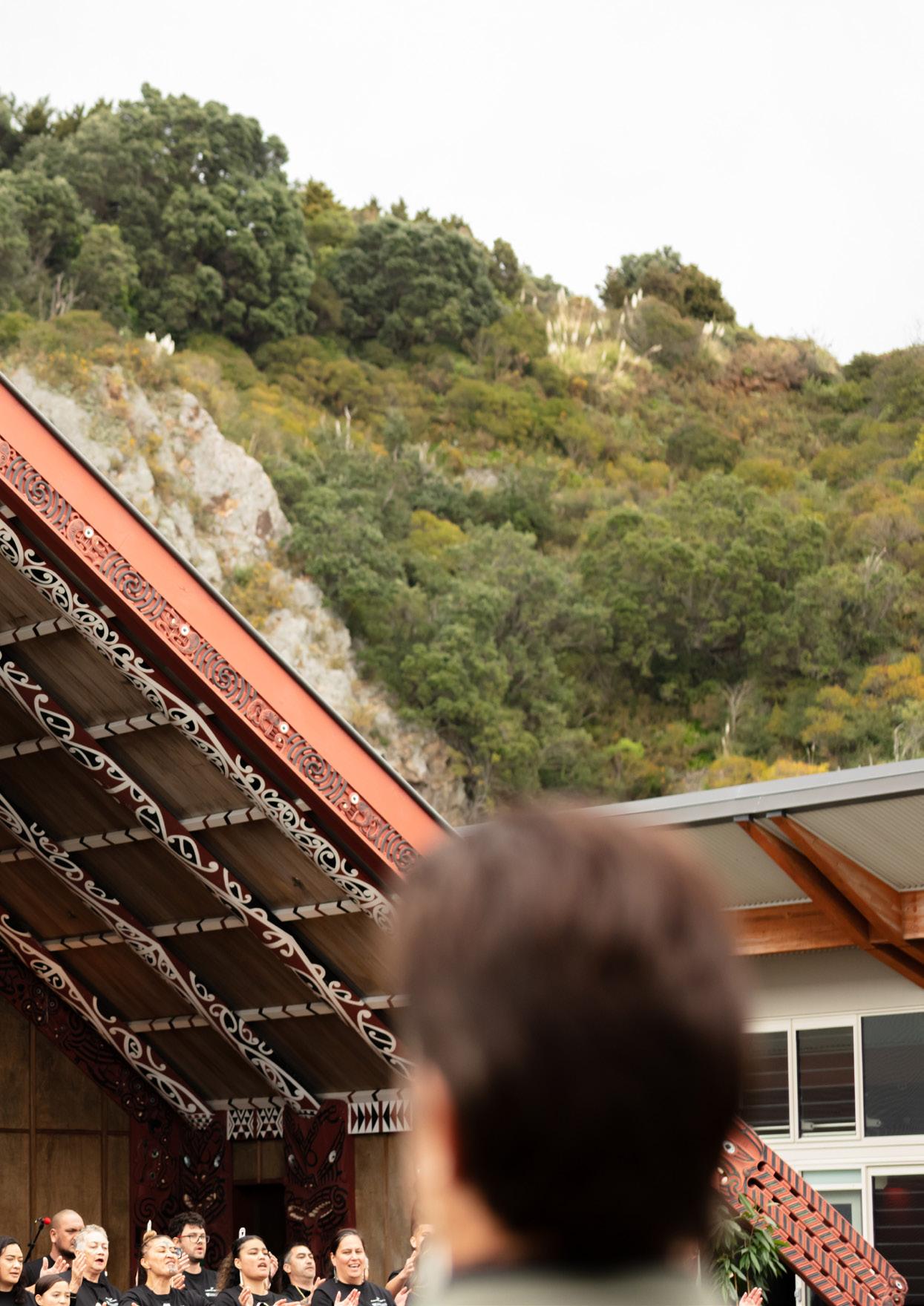





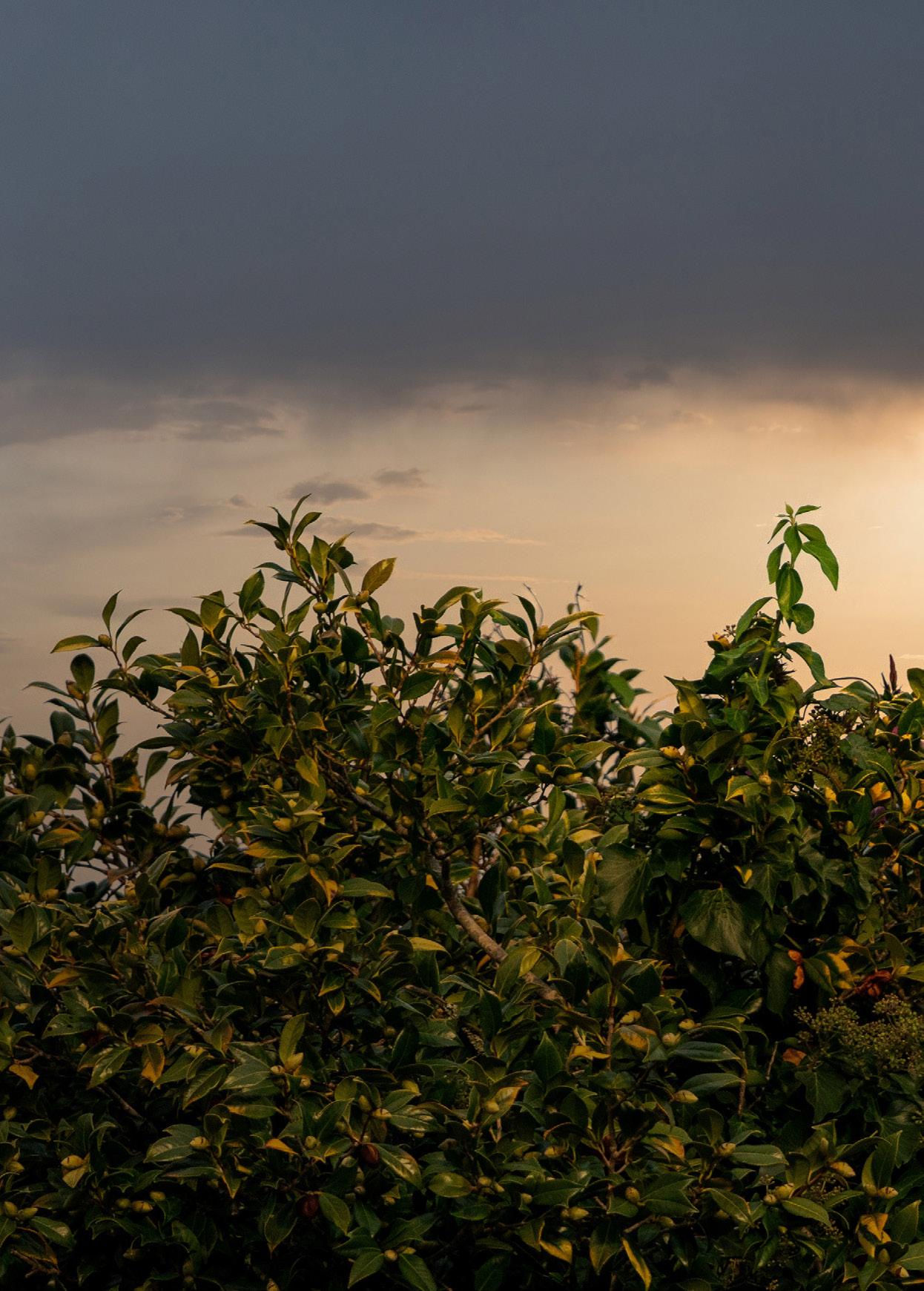



Whakarongohia ake tēnei te toki e kakapa nei, Kā tangi te wawara. I te mata o Tāne kia noho mai kōrua, Hai hura I te iwi e aue te mamae.
It is that the sound of an adze that has caused a disturbance within the realm of Tāne. The remnant of that sound is that of grief and pain.
Ko Te Kei o te waka ka tahuri ki tua o whakaaro nui,
The stern of the waka (Te Kei) that has submerged into eternal memory
E Tama e oho I te ara kauika.
May you rise oh sir (Tamaoho) to traverse the final path to the heavens.
Mā wai e whakaara ake i te waka kua tīkoki. Mā wai e whakatika i te Iwi kā hē. Mā wai e taurima i te marae kai waho.
Who will guide the waka as to not deviate? Who will guide the Iwi as to not fail? Who will maintain the prestige of our Whare?
E te Ikahuirua o Awa Takoto rawa iho I te kākākarauritanga o te ahiahi, Moe mai rā.
Oh our two esteemed Rangatira. May the setting sun pay eternal homage to you. May you finally rest.
Nā reira, anei rā ngā uri o Ngāti Awa e mihi ana, e tangi ana ki a koutou kua riro atu ki tua o te ārai.
A brief reflection of a year that has passed so quickly. In 2022 our trienium rūnanga representative elections were held and a number of new hapū representatives were appointed. Thank you to all the former representatives for their past mahi. To our incumbents and those who have joined us, I look forward to working with you towards the enhancement of the health and wellbeing of our people and the Taiao.
It has been a privilege to inherit the role of Chair of TRoNA from my predecessor Joe Harawira. I am grateful for the invaluable guidance Joe has afforded me in the time I served as his deputy and acknowledge the legacy left by all past Chairs, who dedicated so much of their time for our iwi over the years. I acknowledge the appointment of our Deputy Chair Manu Glen. She offers a wealth of experience, having been a TRoNA board representative for many years. In April 2022 we welcomed our new TRoNA CEO Reuben Araroa. Reuben brings a wealth of knowledge, skill and expertise and is passionate about achieving positive outcomes for our people.
Post election, we are under no illusions of the changes on the horizon within the next 3-6 months. There are indications that the new Government will repeal, replace or re-reform Health, Education, Infrastructure and Environmental sectors. Climate change, the cost of living and the general health of our people are significant and are impacting whanau-hapu-Iwi. We are conscious of the amount of work TRoNA has ahead of us, but our history is a testament to how resilient, adaptable and innovative we are and will continue to be. Ngai Māori have lived in the face of adversity mai rānō so addressing and overcoming such challenges is inherent.
We must remember to pause every now and then to acknowledge achievements and celebrate our Ngāti Awatanga. Here is a snippet of some key milestones of note:
Ka pōwhiri a Raetihi kāwatawata kōangiangi, Ka karanga ngā ngaru whatiwhati o Te Moana nui a Toi Kā waiata mōteatea ngā pōhutukawa o Moutohora E kokoiā, e ara e.
Te Nanao Manu Kuia was the re-awakening of a Ngāti Awa cultural imperative in 2012, after 50 years of laying dormant. Our koroua Te Kei Merito worked tirelessly with Crown agencies to have this Ngāti Awa tradition reinstituted. In acknowledgement, we returned to Moutohora last month after a 2 year absence, to implement our traditional nanao Kuia Oi. E te rangatira Te Kei, kei konei tonu mātou e mahi ana ngā mahi i waihotia mai e koe. Otira e te Pāpā, kei te mihi, kei te mihi.
Taranaki Hononga
Under the guidance of our Whakaruruhau, Tohunga and a number of Ngāti Awa kaumātua, we travelled to Taranaki to recognise and reinvigorate our iwi hononga with Te Ati Awa. A great wānanga was had with our Te Ati Awa whānau whānui at Ōwae marae, Waitara. Te Ati Awa will return the compliment and join Ngāti Awa next year at Te Mānuka Tūtahi to progress this hononga.
In December last year a selection of prominent Tohunga from Mataatua and across the motu came together to address Te Wete i te Whiu a Te Tahi o Te Rangi. The Karakia Whakawātea ceremony was prompted by local Tohunga Koro Tutua, supported by our Whakaruruhau and Ngāti Awa Kāhui Kaumātua. Professor Pou Temara led the Tohunga roopu, performing series of karakia tawhito o Tuaukiuki mai i Pohaturoa ki Te Haehaenga.This was a once in a lifetime event that will be remembered by those who took part in the removal of the whiu and by all of Ngāti Awa. That has cleared the way for Ngāti Awa to move forward.
We must celebrate the Reo Rua Strategy that our kaimahi within TRoNA are leading, with the help of our kaimahi Māori within the Whakatāne District Council; with the intention of making the Whakatāne District a Rohe Reo Rua.
Matariki is now a statutory holiday and is celebrated across the Nation. Ngāti Awa hapū and whānau held ceremonies across our rohe to recognise its relevance as a tohu for the Māori New Year. In 2022 Matariki was experienced out at sea in close proximity to Whakaari and Te Paepae ki Aotea. This year an inaugural Matariki event took place at Te Kupenga which saw hundreds of whānau and hapū gather to remember and pay respect to those who have passed on.
In closing, I extend my sincere appreciation to our Whakaruruhau, TRoNA Board Members, Te Kāhui Kaumātua, our NAGHL team, our Rūnanga Kaimahi and all those who have contributed and volunteered their time to realise the aspirations of Ngāti Awa.
Mā te Ātua tātou e manaaki, e tiaki i ngā wā katoa.
Naaku noa
TUWHAKAIRIORA O’BRIEN Chair, Ngāti Awa

Tēnā tātau, April 2023 marked my one-year anniversary and as you read this report, I would have reached the 18-month milestone. On reflection of that time served, the most prominent thought is of gratitude for the patience and support provided by Te Rūnanga o Ngāti Awa Board, our staff and our hapū. The year has been another steep learning curve derived from an ever-increasing awareness of the critical obligations we have for hapū and our Rūnanga. The accountability to ensure we are across the omnidirectional flow of obligation provided greater appreciation of the complex work environments of previous Manahautū. I want to acknowledge their hard work and contributions to get the Rūnanga to where it is today.
Ko te pae tata kua tau, kua ea. Ko te pae tawhiti whāia kia mau.
In review of the year, I am pleased the Rūnanga has demonstrated tangible improvements with operating efficiencies, organisational teamwork and growing internal capabilities. All of which are a prerequisite for serving our hapū more effectively. Promotion of Ngāti Awa uri who serve within the Rūnanga from kaimahi to leadership and management roles has been an excellent example of this in action. Leading amongst your own people can be challenging and I would like to acknowledge Simon Harris, Sienna Walker from Korehāhā Whakahau, Karla Akuhata from Communications and Engagement, Ngaire Rapana from Information and Technology and Kataraina Monica from Taihuringa who led her team through significant management and personnel changes early in her tenure. The appointment of Mike Panapa as Pou Kōkiri has also delivered a step change of internal cultural capability enhanced by the guidance of our Pakeke across our hapū. I also acknowledge Vaimanino Harawira who continues to lead the transition with Te Mānuka Tūtahi from a tourism to event hire focus. Her demonstrated resilience with change has been another exceptional example of adaptive leadership that delivers positive results to the wider Ngāti Awa Group.
Acknowledgment must also extend to the remarkable effort of all our Rūnanga teams to embrace the reset of our financial management systems. The activities ranged from changes to operating routines, financial authorisations, increased monitoring of budgets and ending many discretionary expenditure items. The end of year result demonstrates a positive step toward our desire for greater financial management leading to future increased benefit to hapū. Our external relationships have also improved. This is signalled by many meaningful collaborations across the year with central government, local and regional councils, universities, and several business entities and trusts. These relationships have provided an enhanced view of the future allowing the Rūnanga and hapū to be better informed to appropriately influence any oncoming change in advance. The significance of our affiliated relationships continues to grow with Te Whare Wānanga o Awanuiārangi, Tumeke FM, Te Tohu o Te Ora o Ngāti Awa through providing people, organisational resource, and leadership support to the Rūnanga. We thank all our affiliates for the continued support and look forward to even richer and more exciting collaborations into the future.
We should also be positive about many of the current legal cases we are engaged with. The first to be acknowledged is the Ōpihi Whanaungakore archaeological appeal case. To have the developers initiate an adjournment (postponement) one day out from the Environment Court sitting is a testament to the collective influence of the Ōpihi Whanaungakore Lands Trust, Ngai Taiwhakaea, and Protect Ōpihi Whanaungakore rangatahi roopu.
The Creswell NZ case saw our appeal being elevated to the Supreme Court setting a precedent for leave being granted from the High Court case based on our tikanga grounds that the Court of Appeal refused to hear. Creswell NZ has also withdrawn from the development with Otakiri Springs taking its place. The Supreme Court will hear our appeal in November 2023.
However, there are still many legal challenges ahead that require further focus and attention such as our outstanding issues with aspects of the treaty settlement of Te Whakatōhea, the claims under the
Marine and Coastal (Takutai Moana) Act 2011 and an outstanding item from 2015 related to the Five Iwi Afforestation Programme (currently co-ordinated by Ngai Tahu). Thank you to our hapū led sub-committees and legal counsel for the significant amount of work carried out over the last year.
We must also recognise the influence of a rapidly changing world and the uncertainty it will bring for iwi. From climate change, government reform, cost of living issues, politicising of Māori as a narrative, we are witnessing unprecedented change within the fabric of Aotearoa. This year I sought approval from the Board to review our current strategy that achieves our Vision in 2050. A key proposal in the strategic review is to consider Vision achievement in 2030 delivering greater value to hapū within a shorter timeframe. As experienced with COVID, system change can take place over night, and I believe the Rūnanga must do more and do it sooner to support the uplift of hapū capability and provide greater employment opportunities for whanau. As we progress through the review, we welcome your continued feedback to help guide our thinking.
On a personal note, I want to acknowledge the deeper appreciation I have for the mana of Ngāti Awatanga and our specific tikanga, kawa and reo. Without exaggeration, over the last year I have spent more time on our marae, in powhiri and whakatau than I have in my entire life. Through this experience, I have witnessed the stoicism and sacrifice our Pakeke and Ahi Kā provide to maintain the mana of hapū and Ngāti Awatanga as a cultural narrative. To you all, I acknowledge your mana.
To our kaumatua, I sincerely thank you for your presence, guidance and support during the many interactions over the year. You are also a constant reminder of the sacrifice and commitment made by the many generations who have come before us.
To my new Chair, Deputy Chair and Board of the Ngāti Awa Group, thank you again for the patience and guidance you have afforded me this year. I am aware of the continual need to improve and deliver greater value for hapū into the future.
Ki taku rahi o Te Māpou. Ko ngā whakamihia kia kautau he mutunga kore.
Tū te ringa, Tū te mana, Tū te mauri.
Ngā mihi nui,
REUBEN ARAROA
Manahaūtu, Te Rūnanga o Ngāti Awa
Tēnei te ara ki a Ranginui rāua ko Papatuānuku. Ngā rau a ngā tapuwae o Tāwhaki, o Tanenuiārangi.
Ngā mate ki tua o ngā ihoiho o Roimata Turuturu, o Paepae o Aotea, haere ki ngā kāhui whetū, haere Te Kei Merito, haere Ngamihi Crapp mā, haere, whakangaro atu ki te Pūtahitanga o Rehua, o Matariki hei tohu mā tō iwi.
Ki a tātau te hunga ora, ngā kaihoe a tēnā waka, o Ngāti Awa; Ngāti Awa ki Uta, o Ngāti Awa ki Tai, mā wai te waka e hoe, māu? Māku?
Mā tātau katoa te waka e tō.
NGĀ HUI
I JULY 2022 TO JUNE 2023
10 August 2022
05 Oct 2022
10 Nov 2022
13 Apr 2023
20 June 2023
RANGITUKEHU PAUL
Chairman For Te Kāhui Kaumatua
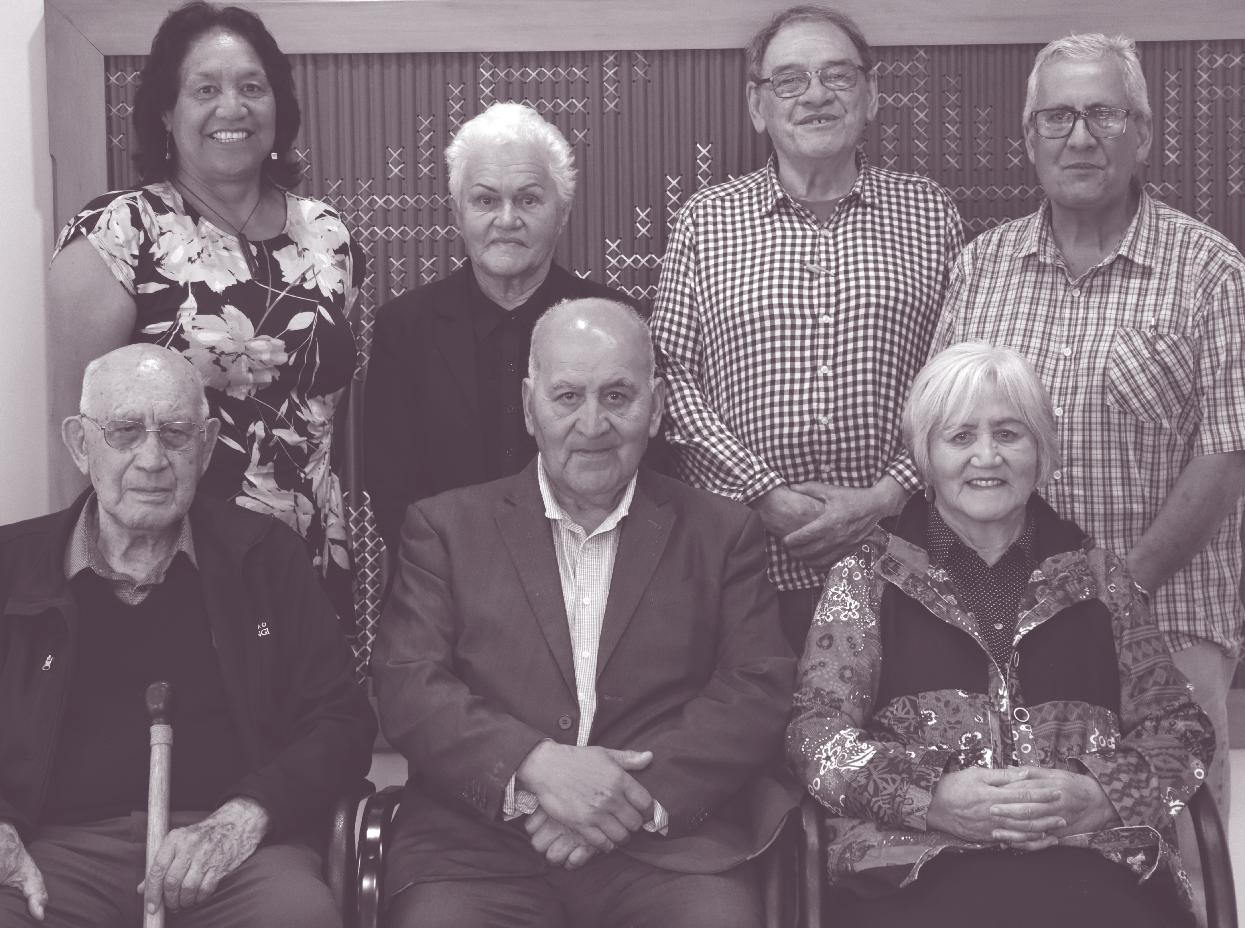


The Board of Representatives comprises of members from each of the 22 Ngāti Awa Hapū. They are responsible for the governance of Te Rūnanga o Ngāti Awa.
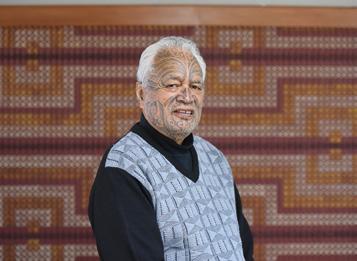
MARK (JOE) HARAWIRA (Chairman) Ngāi Taiwhakāea II

TŪWHAKAIRIORA O’BRIEN (Chairman) Te Pahīpoto

WILLIAM STEWART Ngāti Hokopū ki te Whare o Toroa

KINGI Ngāi Tamaoki

MATEROA DODD Wharepaia
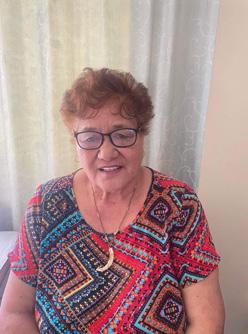
MERE KINGI Ngāti Pūkeko


ALF MORRISON Ngāi Tamawera



MANURERE GLEN (Deputy Chairman) Ngāi Te Rangihouhiri II
TE WHAUHUIA KOOPU Ngāti Maumoana
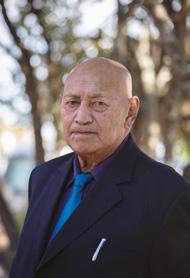
KEI MERITO Ngāti Rangataua

MIRO ARAROA Ngāti Hāmua
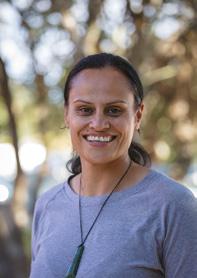
MIHIPEKA SISLEY Te Kahupāke
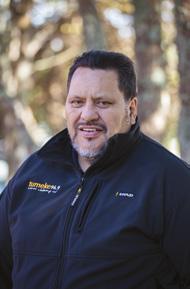
STANLEY RATAHI Ngāti Hikakino




MASON Ngāti Awa ki Tāmaki Makaurau

HEPI Tūariki (Elected 26.11.22)


MURRAY Ngāi Tamapare


AROHA MEAD Ngāti Awa ki Pōneke (Elected 26.11.22)
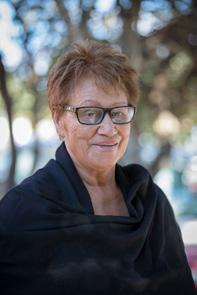
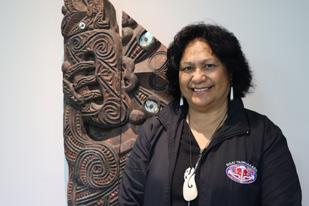
TAKOTOHIWI Ngāi Taiwhakaea (Elected 26.11.22)




GRAHAM General Manager, People & Capabilities
General Manager, Strategy & Policy TRONA



MCCORKINDALE Board Secretary/EA to Manahautū

RERE WILLIAMS Receptionist Transferred to Comms & Engagement 13 Feb 23
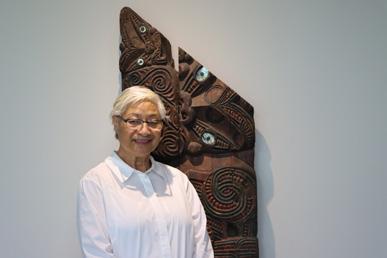
Receptionist Transferred to PMO
Receptionist Joined 1 May 23


NOTI BELSHAW Manager Culture, Research & Archives
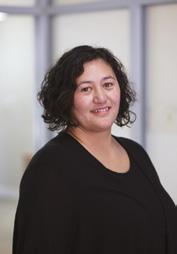
JACKELINE WHAREWERA Manager Knowledge & Information Resigned 13 Jan 23

BEV HUGHES Interim Manager Taiao





MARIU Joined 14 Nov 22



GEORGE Seconded from ESR

CABLE Joined 16 Jan 23

AKUHATA Manager, Communications & Engagement


Senior Communications & Engagement Specialist
& Engagement




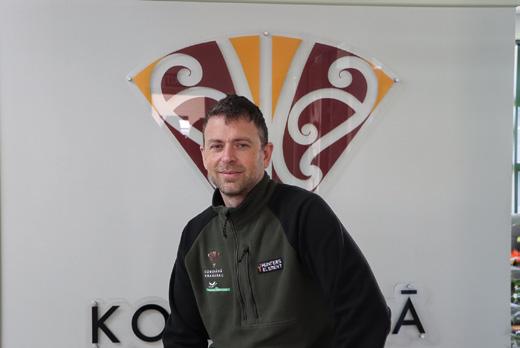




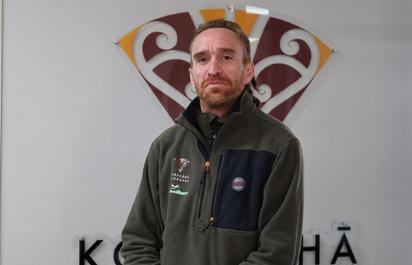
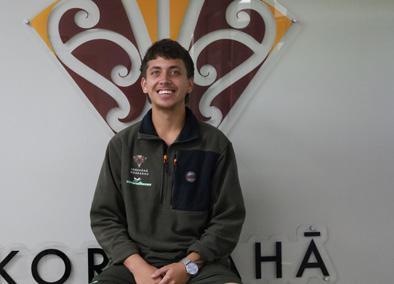
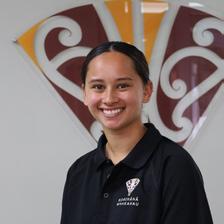


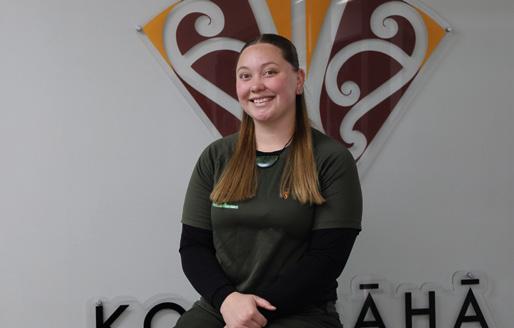

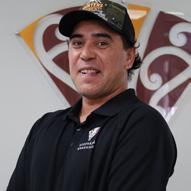



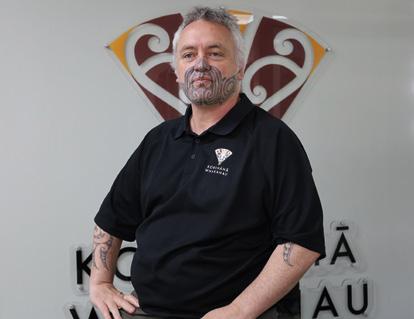
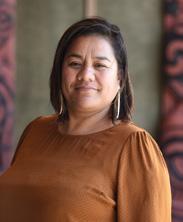


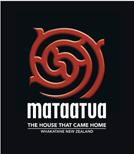











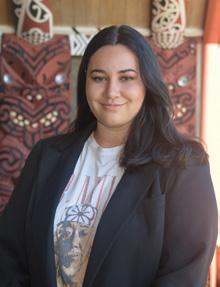





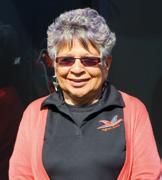















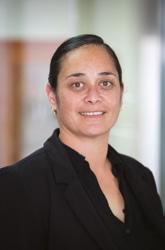


JENNIFER GOODFELLOW Finance Assistant






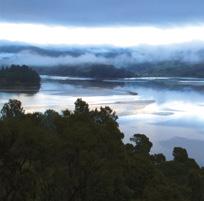


Ko Ngāti Awa Te Toki Tē Tangatanga i Te Rā, Tē Ngohengohe i te wai
GOVERNANCE REVIEW
Review the effectiveness of the Governance structure across the Ngāti Awa Group and make recommendations to the TRONA Board.
CHARTER REVIEW
Review due in December 2023. Committee to be set up to carry out review and make recommendations to the TRONA Board.
Strengthening the bindings of the adze: Our culture. Our Environment. Our resources. Our people.
FOCUS:
• Consolidation
• Clarity
• Connection
FOCUS:
• Raise Internal Capability
• Identify the needs of our hapū
• Influence our external stakeholders
WHAT WE WILL DO:
• Governance and organisational structure review for Rūnanga
• Integrate internal & external plans
• Create Interdependency of delivery goals
WHAT WE WILL DO:
• Internal & external Karakia/Waiata/ Te Reo/Tikanga wānanga
• Develop Ngāti Awatanga centric resources
• Develop Ngāti Awatanga Reo Rua strategy across the rohe
FOCUS:
• Embrace our culture as a form of wellbeing
• Understand the opportunities for Iwi wellbeing
• Connect at the hapū level
WHAT WE WILL DO:
• Deliver events for whakawhanaungatanga
• Grow our ability to gather and analyse data
• Identify quick wins for influencing hapū
FOCUS:
• Effective engagement and communication
• Create clarity and understanding of the Rūnanga
• Connect at the hapū level
WHAT WE WILL DO:
• Confirm the engagement and communications strategy
• Collaborate with media platforms to distribute knowledge
• Attend hapū hui to share face to face
FOCUS:
• Deliver on our obligations
• Streamline stakeholder processes
• Identification of social and environmental opportunities WHAT WE WILL DO:
• Confirm clear well understood KPI’s aligned to contractual obligations
• Confirm consenting and service process and value with stakeholders
• Attain social funding to seize adjacent opportunities
Review is due against requirements of the Charter. Manahautū to lead review, engage with hapu and affiliates and make recommendations to the TRONA Board.
Manahautū to lead review and make recommendations to the TRONA Board.
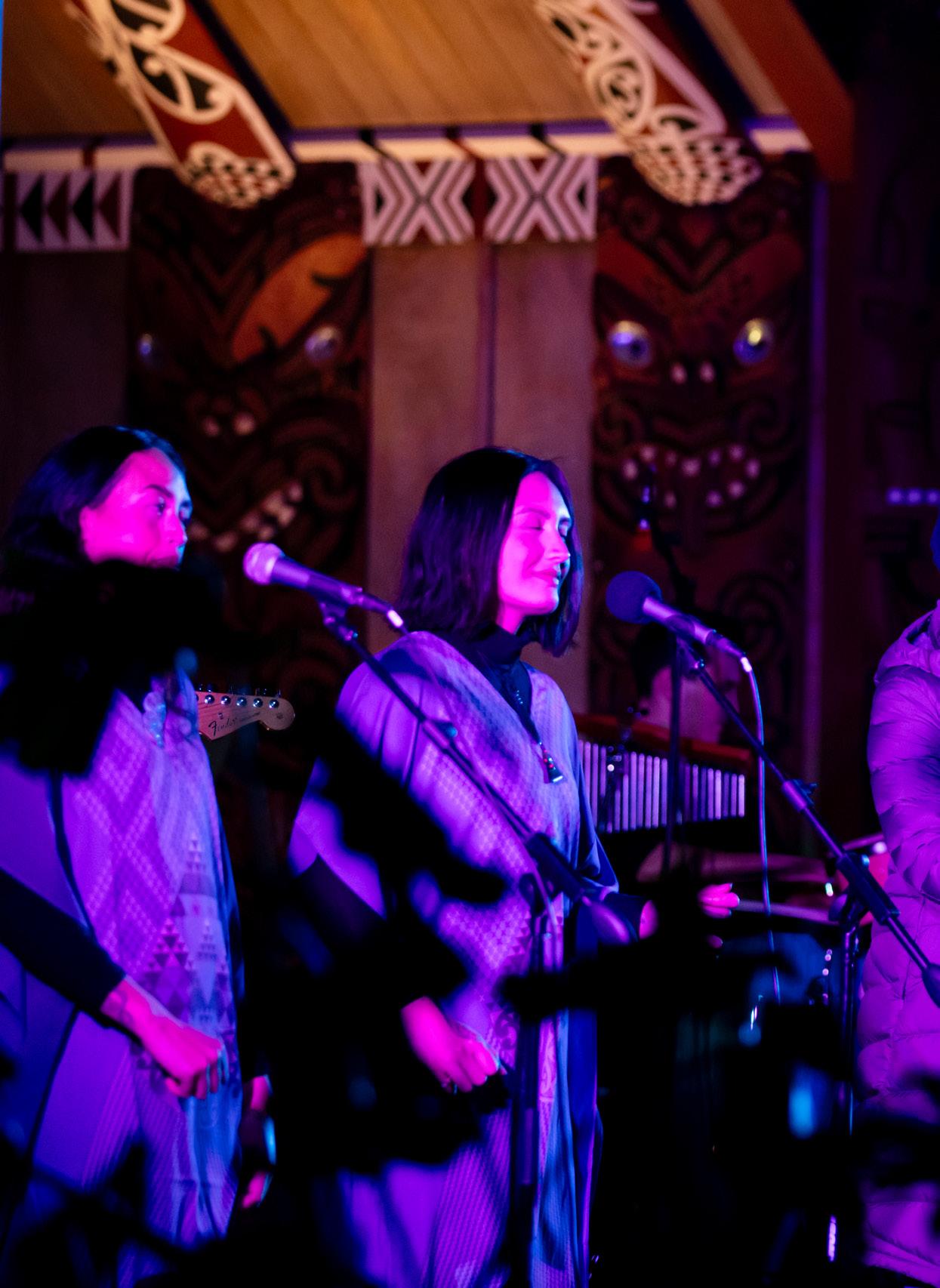
Our shared obligations to care for one another, with particular emphasis on caring for our youth and our elders.

Represents our obligations to protect our culture, our environment, our resources and our people today and for future generations, in accordance with our cultural practices.
Uphold and protect our language and culture - which derive from our shared ancestry - as the cornerstone of our unique identity.

$1,258,485
FIRST NAME
Wharepakau
Tia Margaret
SURNAME
Akuhata
Ngati Maumoana
Araroa Ngati Hamua
Raeana Araroa Ngati Hamua
Erina Brown Ngai Tamapare
Finnian Callum
Jack MacGibbon
Ngawati
Te Aniwa Waiharakeke
Marama Rose
Cheyne Ranei Ariana
Tamahou Hayz Huihui
Campbell Ngati Rangataua
Campbell Ngati Pukeko
Cook Ngati Rangataua
Cook Ngati Rangataua
DISCIPLINE
Masters
Bachelor
Undergraduate Bachelors
Bachelor Degree
Bachelor Degree
Bachelor
Bachelor
Bachelor
Cook Ngati Rangataua Thesis
Copeland Ngati Hokopu Ki Te Whare o Toroa
Corbett Te Pahipoto
Kataraina Robyn Cossey Ngai Tamapare
Sandralee Harata Crawford Ngai Tamaoki
Mataku-Ariki Iris de Roo Ngati Hokopu ki Te Hokowhitu-a-Tu
Sean Merito
Faulds Ngati Rangataua
Ashlea Sarah Gillion Nga Maihi
Dyan Godsmark Ngati Rangataua
Shauna Gray Ngati Pukeko
Daniel Anthony Haynes Ngati Wharepaia
Rosaline Huriana Ngahaka Hei Hei Te Patuwai
Masters
Bachelor
Bachelor
Bachelor
Bachelor Degree
Undergraduate
Masters with Honours
Bachelor
Bachelors Degree
Bachelor
Bachelor
Sierra Tiwaiwaka Hohepa Te Pahipoto Diploma
Tepora Hona Nga Maihi Diploma
Kaea Te Ao Marama
Hudson Ngati Pukeko
Atakura Hunia Te Pahipoto
Wiremu Jerry Ngati Pukeko
Catriona Jobe Patuwai
Bachelor
Bachelor
Bachelor Degree
Bachelor Degree
Abbey-Jean Kaipara Te Pahipoto Undergraduate
Andrea Kingi Ngai Taiwhakaea II
Lacey Tarehi Kingi Ngai Tamaoki
Bachelor
Bachelor
Nathan Edward Mansell Nga Maihi Diploma
Sheridan Nitika Deborah Maxwell Ngai Tamawera
Leah McGarvey Te Pahipoto
Briar Chantelle
Tayla-Surf
Aria Tyler
Bachelor
Postgraduate
Merritt Ngati Hokopu ki Te Hokowhitu-a-Tu Bachelors
Middleton Ngati Hokopu Ki Te Whare o Toroa
Moeke Ngati Rangataua
Bachelor
Bachelor
FIRST NAME
Lynette Hinemareikura
SURNAME
Ngatai Te Patuwai
Pareake Morgan O’Brien Te Pahipoto
Manaia
Pearmain-Fenton Ngati Hokopu ki te Whare-o-toroa
Ngawairere Pihama Te Pahipoto
Chelsea Pomare Ngati Hokopu
Maraea Yvonne Porter Ngati Pukeko
Tahlia Makere Naiti
Potae Ngai Taiwhakaea II
Megan Pareue Ranapia Te Patuwai
Oromairoa
Rangawhenua Ngai Taiwhakaea
Waiana Renata Nga Maihi
Glenda Maria Rewita Ngati Pukeko
Armanii Samson-Labrador Ngai Taiwhakaea II
Tyla Elizabeth Shaw Ngai Taiwhakaea
Emma Ruby
Nathan Te Hurinui
Stewart te whare o toroa
Stewart Ngati Hokopu ki Te Hokowhitu-a-tu
Zoe Struder Ngai Te Rangihouhiri II
Puaawai Maria Te Pou Te Tawera
Aliyah Teirney-Lambert Ngai Tamaoki
Bella Pera Tipene Ngai Tamawera
Manaia
Karamea
Ikey Ihaka Morehu
Shakentah
Tukukino Ngai Taiwhakaea
Tukukino Ngai Taiwhakaea
Tunui Ngati Pukeko
Tutapakore Ngai Tamawera
Katera Tutua Ngai Taiwhakaea
Manawamoterangi Vercoe Nga Maihi
Pareraututu Waimatao Reweti
Waaka Ngati Pukeko
Jade Aaliyah Wahapango Ngai Taiwhakaea II
Misty Tirawahine
Jasmine Atareta
Waititi Nga Maihi
Westrupp Ngati Hikakino
Bennett White Ngati Hokopu ki te Whare-o-toroa
Jim Kauri
DISCIPLINE
Bachelor
Bachelor
Masters
Bachelor
Bachelor
Bachelor
Bachelor
PhD Thesis
Postgraduate
Bachelor Degree
Bachelor
Bachelors Degree
Bachelor
Bachelor
Masters Degree
Bachelor
Postgraduate Certificate
Bachelor
Bachelor
Bachelor
Masters
Bachelor
Bachelor
Bachelor
Bachelor
Bachelor
Masters Degree
Bachelor
Bachelors Degree
Bachelor with Majors
White Nga Tamapare Diploma
David Whittle Ngai Taiwhakaea Diploma
Te Awhitu
Kimberley
Jennifer Margaret
Wilson Ngai Tamaoki
Wood Te Patuwai
Woods Ngati Pukeko
Masters
Undergraduate
PhD
Kooti Rangatahi continues strongly with the support of all those involved. Once again, I acknowledge our Kaiwhakawā, Louis Bibois, the chief instigator to bring Kooti Rangatahi to the marae. The Lawyers, Court Staff, Lay Advocates, Police and the marae.
As the years roll by the legacy of those who’ve gone before remains. It’s proper to acknowledge also people like Joe Mason, Te Tuhi Mate, Claude Keepa, Maanu Paul ma, who without them, we wouldn’t have kooti rangatahi being held on our marae today.
E koutou ngā pou tokomanawa o te marae o te Kooti Rangatahi.
Koutou i tu pumau i ngā whakawhiu o Tawhirimātea.
Kua ngaro rā koutou ki te pō roa, te pō tangotango, te pō ka kore e hoki mai.
Noho okioki atu i ngā ringa kaha o te Atua.
“Haere, haere, haere atu rā
Heoi ano, ka tika te kī, “mate atu he tētē kura ara mai ano he tētē kura”
“When a leader falls another rises to take his place”.
And so it is with Kooti Rangatahi today. We have great support from people from Ngati Awa Hapu and surrounding iwi who are willing to carry on the work laid down to help to seek an outcome that can provide a better pathway for our Rangatahi.
No reira ka tika hoki, ka tuku mihi nui ki a koutou katoa.
Charlie Bluett Kooti Rangatahi Coordinator.


Final mussel restoration report for Awhi Mai Awhi Atu, Sustainable Seas, National Science Challenge Project.
Mussel restoration stations: The Awhi Mai Awhi Atu project and associated funding from the sustainable seas National Science Challenge concluded in June 2023. Currently there are 4 mussel restoration stations in the harbour. The stations have been successful at recruiting mussels and assisting the generation of three new mussel beds on the harbour floor. In 2019 population surveys identified that there was 1 mussel bed remaining in the harbour with an estimated 78,000 mussel. Further population surveys 2021 identified 3 new mussel beds in close proximity to the restoration stations with an estimated 750,000 mussels on the seafloor. In July 2023 a further 3.5-hectare mussel bed with an estimated 16 million mussels was identified under restoration stations 1 & 2 in the western side of the harbour. The majority of the mussels are juveniles and will require protection from human harvesting to be able to grow to adults, reproduce and help stabilise the new bed.
Seastar management trials: in 2022, a feasibility study for removing 11-armed seastars was carried out in an 8-hectare area on the western side of the harbour using three removal methods: 1) diver removal; 2) trapping; and 3) combined diver removal and trapping. It was found that the diver removal method was more effective at catching larger sized 11-armed seastars with almost 500 seastars removed by 2 divers over a maximum 6 hour diving
regime. The trapping method was more effective at catching smaller animals with 30 traps collecting a further 550 11-armed seastars and 18,900 cushion stars (patiriella regularis) over an 18-day trapping regime. The trial identified that method 3) combined diver and trapping regime, was the more effective method.
Removed seastars were 1) taken to a local worm farm as feed, and 2) made into a hand cream using seastar collagen. (three seastars made 60 pottles of cream)
Considerations: The mussel stations and seastar management trials have been very successful for mussel restoration in Ohiwa Harbour. The Mātauranga māori-led mussel project leads the country in mussel restoration.
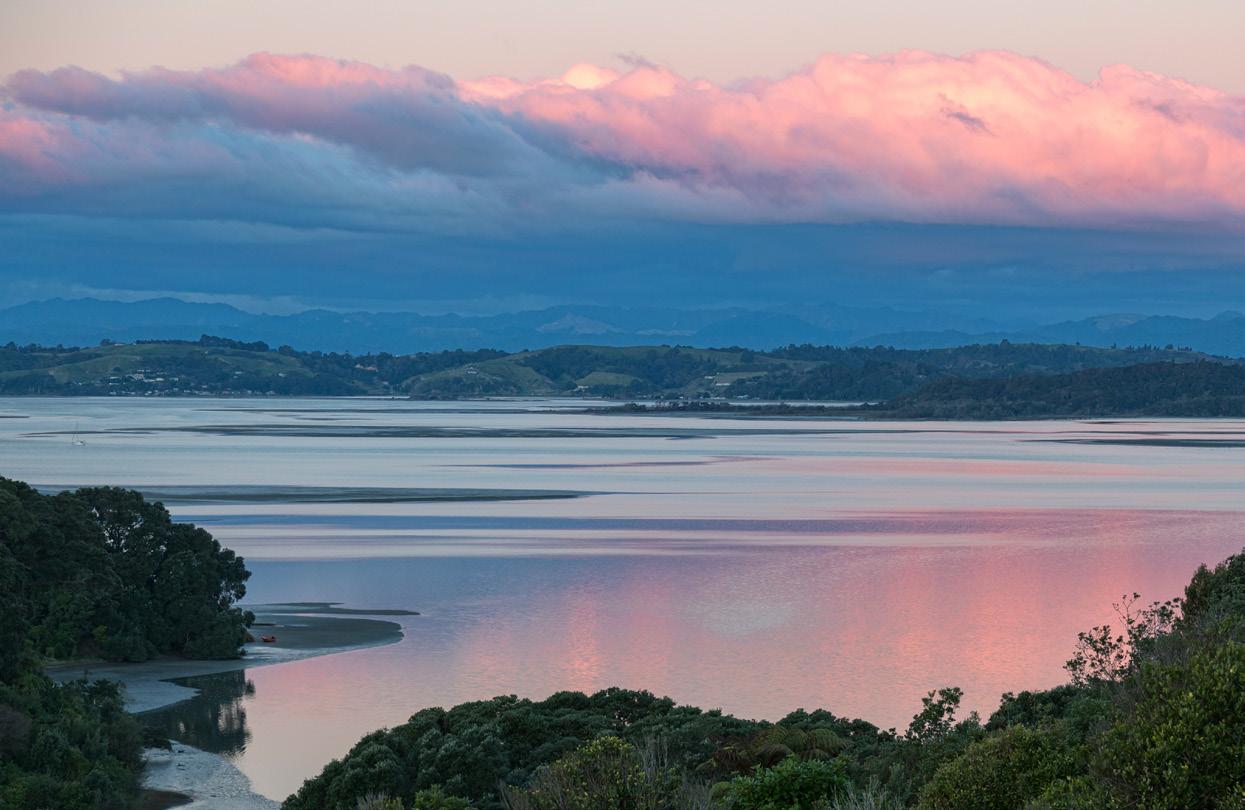
If on-going mussel restoration action was to continue in the harbour, these considerations are required.
1 Maintenance and equipment for restoration stations to assist mussel recruitment.
2 Protection of the new 16-million strong bed to stabilise.
3 Bi-annual mussel population surveys to identify mussel and seastar abundance on the seafloor.
4 Annual seastar management removal to assist mussel retention on the seafloor.
5 Funding.

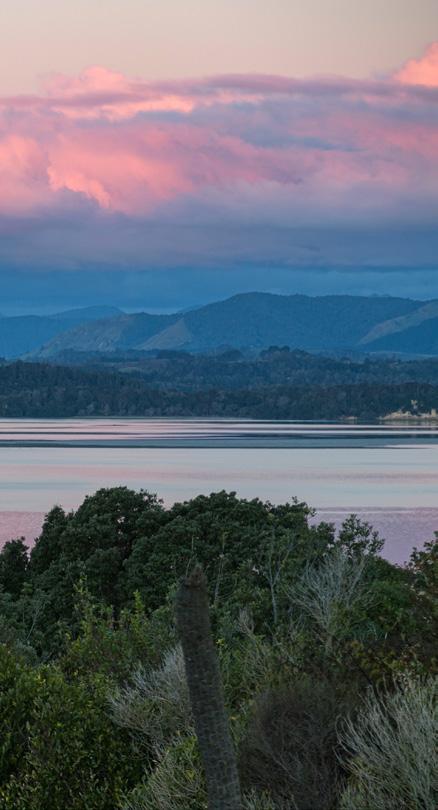
Tuna (Longfin eels) Species: Anguilla dieffenbachia have a complex lifecycle. Most of their life is spent in freshwater, followed by migration to the marine environment for reproduction.
Longfins are one of the largest, slowest growing and longestlived eel species in the world. Females can live for over a century, meaning they may be exposed to the impacts of environmental changes over multiple decades and climate change over their lifetime. Large eels play an important role in determining the population structure and these large eels affect species composition, sex ratios and size distribution. Longfin eels breed once in their life and die after spawning. They can produce millions of eggs and large females are more fecund than smaller females.
Species that are already facing multiple threats are often considered more vulnerable to climate change.
Longfin eels are ranked as “at risk declining” by DoC and “endangered” by the International Union for Conservation of Nature.
Pressures on longfin eels include the commercial eel fishery, in-stream barriers to upstream and downstream migrations, and mortality at Hydrostructures. Roughly one third of the available longfin eel habitat is estimated to be impacted by both Hydroelectric dams and commercial fishing. Drought is recognised as a significant ongoing threat to longfin eel, potentially affecting 50% of the population in New Zealand.
Longfin eels have several characteristics that likely increase their vulnerability to climate change. They migrate from freshwater to the Pacific Ocean to spawn, a spawning migration that spans thousands of kilometres. Sex-specific differences in migration time are known with males generally migrating to sea in April, and females during late April and May. The adult migration to the spawning grounds takes approximately 6-9 months. Females that do reach the spawning area must encounter males and spawn and they reproduce in large aggregations. However, the location of their spawning ground is unknown and therefore spawning behaviour has never been observed.
Gender is thought to be determined principally by environmental factors, particularly temperature, meaning sex ratios are vulnerable to changes in temperature.
Longfin eels are only found in New Zealand. They can travel up to 300kms inland and are distributed from sea level up to 1150 metres elevation. They can be found in many high-country lakes and rivers.
Na, Charlie Bluett Customary Fisheries Manager
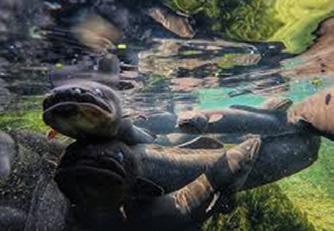
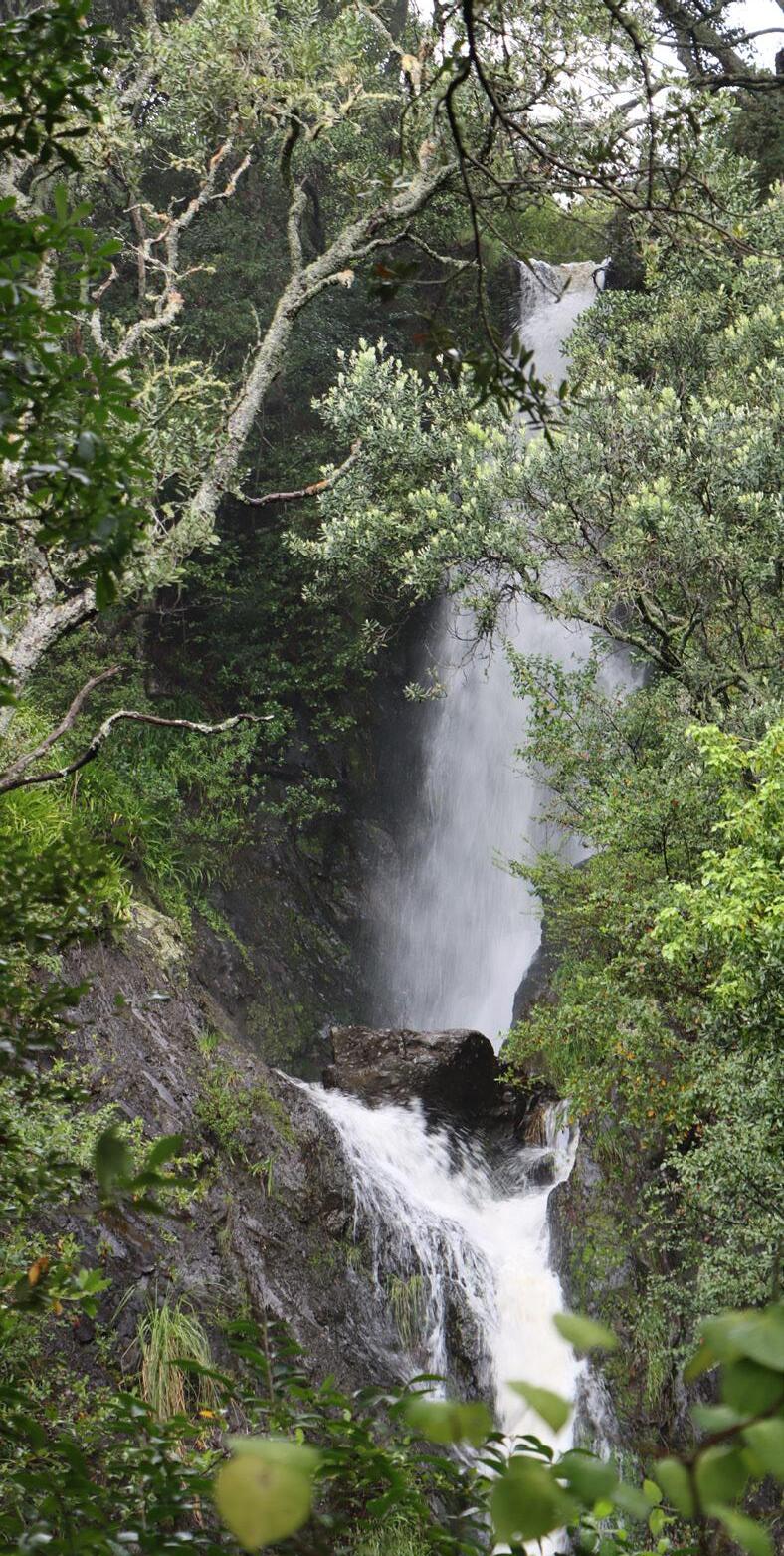
Tātai ngā whetū ki te rangi, mau tonu, mau tonu, tātai te tāngata ki te whenua, ngaro noa, ngaro noa, toi tū te mana o te whenua, tu tonu, tu tonu.
The starry hosts of heaven abide there forever
The hosts of men upon this earth will pass away into oblivion to be forgotten whilst the authority, dignity, and integrity of the land remains immutable.
DEDICATED TO THE MEMORY OF TE KEI O TE WAKA MERITO, ONZM


Appointed in June, Harawira-Cook (Te Patuwai, Ngāti Rangatauā, Ngā Pōtiki) commenced in the role of Manager Taiao on the 27th of July 2023.
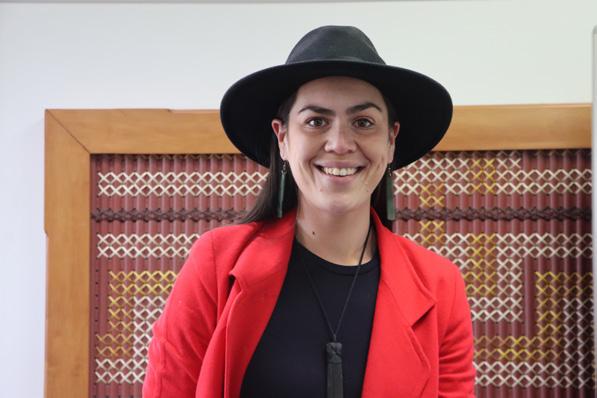
Marama holds a Bachelor of Humanities degree, double major in Policy and Indigenous Studies and was the recipient of the 2020 Raewyn Good Scholarship towards completion of her master’s degree ‘Ngā Ewe Whakawhenua: Beyond the Green Chain era – an experiential collation of Wāhine voices from a Ngāti Awa women’s perspective’, Marama is now Manager Taiao, where she continues as a passionate advocate for sustainable practices and a dedicated researcher and environmentalist.
Former Waka Huia Director, TūmekeFM radio host, and television presenter for Whakaata Māori – Māori Television, Toi Te Ora, Pohoira brings a wide range of experience to the position of Kaihautū Wai Māori as Te Au o Te Wai o Ngāti Awa Project Team seeks to work with hapū on building tools that uplift and support Ngāti Awa kaitiakitanga and decision-making for freshwater in the Ngāti Awa rohe.


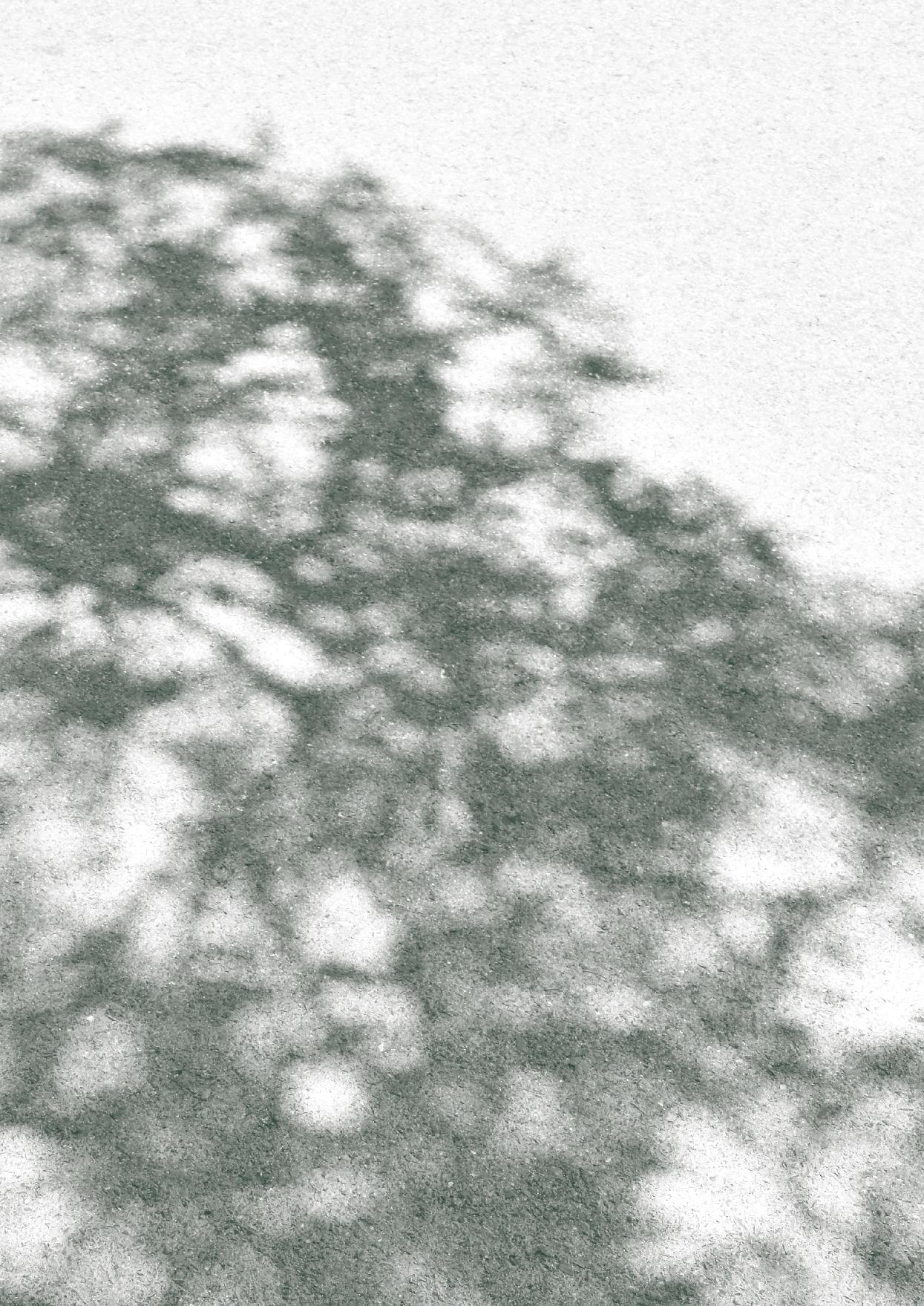


Manager Korehāhā Whakahau
We bid farewell to John Eruera on 7 April who left to take up the role of Health & Safety Manager at Waiu Dairy Company in Kawerau.
John was instrumental in establishing Korehāhā Whakahau operational routines and standards. Johns sound, professional and conscientious advice, balanced management style helped initiate and maintain the solid collaborative vibrations still enjoyed by all team members today.

We were delighted to celebrate Simon Harris’ appointment to the role of Operations Manager Korehāhā Whakahau.
Si rose through the ranks, starting as a Kaimahi then promoted to being one of two Kaiarahi to now achieve the Manager Operations position.
The positive vibe John Eruera established is being successfully maintained and enhanced under Si’s leadership. The team is buzzing with successful innovations including free renewal of ZIP technology components and the Job Share of the Acting Kaiarahi role by Tom and Summer. These are testament to the seamlessness with which Si has fitted into the role that John established.

Tom and Summer share the Kaiarahi role that was vacated by Si Harris. This provides opportunity for professional development while maintaining the positive vibe and productivity in the crew.

The amazing conference led by Korehāhā Whakahau in September 2022 was attended by more than 60 participants from around the motu. They came together at Te Mānuka Tūtahi to share about how they protect the mana of the whenua as kaitiaki and tangata o te whenua.
The conference aimed to exhibit the capability, voice, role, and leadership of mana whenua in achieving a predator-free future. Designed by Karla Akuhata (who beamed in from Whakatāne Hospital), co-hosted by Merenia Sawrey and Pohoira Iopata,
and championed by the late Te Kei Merito, the conference provided space for like-minded kaimahi to share and showcase to Predator Free 2050 Funders, their:
• Indigenous perspectives and paradigms about the threat pests pose to our respective rohe
• Indigenous-led solutions in the protection of native species.
• Preserving indigenous knowledge and mātauranga pertaining to biodiversity and ecology
• Building the capability of mana whenua involved or leading PF2050 projects.
• Exchanging stories, opportunities and challenges towards shared growth
• Removing barriers to mana whenua engagement, participation and leadership in the PF2050 Vision






L to R: putting a wax tag on a rākau; close up of the wax untouched; close up of a bitten wax tag.
Korehāhā Whakahau kills possums using traps and hammers, but not poisons! Maps help us plan where to focus our activities of removing possums and defending those spaces by monitoring those places to ensure possums stay out.
Korehāhā Whakahau has carried out a wide range of activities this year including the wax tagging programme in Kōhī Reserve alongside our Ōmataroa Kaitiaki crew, installation of cameras and lengthening our defensive fence line, testing for the presence of possums using flour and icing sugar baits in Mokorua Scenic Reserve to inform our trapping plan, to helping HALO and Whakatāne Kiwi Trust with their pest management actions in areas and with landowners we have in common.
As well, our Korehāhā Whakahau crew maintain a continuum of professional development activities for kaimahi including work-based training exercises with Vertical Horizonz, St John’s First Aiders and alongside our Te Papa Atawhai colleagues who provided the opportunity for three kaimahi to attend Te Hira Pū-Ao Conference in Rotorua which, like our own Taurikura
The defensive fence system we aim to stretch from Ohiwa to Whakatane awa aims to ‘close the gate’ and lock the possums out of the eradication area.
Anamata Conference, was an event provided for Māori by Māori working in the Taiao and Mātauranga space.
Five of our kaimahi also attended the Annual Predator Free 2050 Wānanga event held in Ōtepoti where Dr Rob Whitbourne (Mātamua Rangahau) and Karla Akuhata (former Marketing & Communications – Korehāhā Whakahau) delivered presentations on the topic of Mātauranga.
Left map shows the removal areas achieved and monitored (in white outline) and the defense areas we manage to keep the possums out (green). Right map shows where possum eradication has been achieved and where we focus our ongoing removal and defense acitivites.

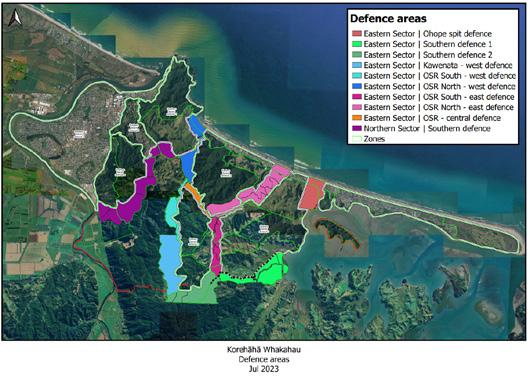
The aim of the Korehaha Rangahau research project has been to explore and invigorate the mātauranga of Ngāti Awa associated with the ngahere i.e. knowledge and practices relating to the plants, animals, waters and other aspects of the forest. Through 2022-23 the research team of Lanae Cable and Dr. Whitbourne have undertaken the following:

Ureure (fruit) of a kiekie. A kai our tīpuna knew well, but today it is usually eaten by rats and possums before the fruit matures. Ripe ureure are a mātauranga based sign of forest health.
Research – archival and published materials from Hāmiora Pio, Himiona Tikitu, Te Tāwhero (Albert OliphantStewart), Samuel Jaram, materials held by Ngāti Awa Research and Archives (NARA), Apirana Ngata and the many contributors to Ngā Mōteatea: Volumes I to IV, Elsdon Best (particularly Forest Lore of the Māori), Ben Keys, Tā Hirini Moko Mead, wide range of mātauranga collections, and many Journal of the Polynesian Society articles and notebooks have been reviewed. This work included writings directly focused on the ngahere, and accounts of life where the ngahere was a place where our tīpuna lived, providing kai, rongoā, building
materials and much more. We also explored karakia, mōteatea, tauparapara and waiata as rich sources of knowledge relating to the ngahere and Te Aitanga a Tāne.
Interviews - A number of Ngāti Awa kaumātua were interviewed, with more interviews to be completed in late 2023. Lanae Cable led this work and was able to hear first-hand accounts from those kaumatua of their own lives, and stories of their parents and grandparents, living close to, and off, the land and sea. These interviews provide the lived experience and context that grounds much of the archival research and are themselves a taonga for future generations.
Integrating Mātauranga into the Korehāhā mahi – through the last 12 months the ngahere was our ‘classroom’, with a number of hikoi and wānanga undertaken. Within the Korehāhā Whakahau team, one person stood out as a mātauranga champion, that was Rangipai Eruera. Rangipai would provide daily maramataka updates, create resources for specific birds and rākau, and always encouraged the whole team to learn and grow.
During this period, we were able to support Dr Ramari Oliphant-Stewart MNZM to return to hold wānanga at Te Whare o Toroa Marae (Wairaka Marae) about whales (for Ngāti Awa and across the Pacific), freshwater, and the ngahere. Both kōrero were recorded, shared with her and her hapu Ngāti Hokopū ki te Whare o Toroa, and are held in NARA as a

resource for current and future kaitiaki taiao o Ngāti Awa whānui. Korehāhā kaimahi also visited ngahere within their operational area with Whāea Ramari, allowing the wānanga to continue in the bush. Ramari also accompanied the Korehāhā team to the Predator Free 2050 Ltd Landscape Project hui, where both Dr. Whitbourne (senior researcher) and Whaea Ramari presented on mātauranga taiao. Liliana Clarke also presented to the team on maramataka, Mataariki, and tohu taiao, providing more valuable mātauranga to integrate into their work.
KUPU WHAKAKAPI
In many respects, 2022-23 represents a ‘stage’ of the journey to understand and embody our mātauranga taiao. The ngahere has its own language, and embracing mātauranga taiao requires us all to learn, to hear, and to communicate with the ngahere again. It is not a ‘one wānanga and we’ve got it’ affair, it requires a lifelong commitment to learning and growing. The wānanga, hīkoi, and resources provided through the research project will play their part in supporting that returning to the ngahere, our collective learning, and ensuring the tāonga of mātauranga-a-tīpuna continues to be reinvigorated with each generation.
And finally, a special mihi is offered to our kaumātua, Te Kei o te Waka Merito ONZM. An inspiration, support, guiding figure and koro to all of us in Korehāhā Whakahau. Many hours of discussion occurred around this particular kaupapa and bringing our mātauranga to life, in the ngahere. Places like Moutohorā, was something you had a lifelong passion for. In its own small way, may this research play a part in fulfilling your dreams, that by gathering together these tāonga tuku iko, tāonga koiora, and returning them to the ngahere, both our tuākana and ourselves are invigorated, protected, and sustained.

Funded by Te Mana o Te Wai fund in the Ministry for the Environment, Te Au o Te Wai o Ngāti Awa Project aims to facilitate engagement with ngā uri o ngā hapū o Ngāti Awa, to build on our practices of kaitiakitanga and mātauranga in our exercise of kaitiakitanga and decision-making for freshwater in surface water bodies in the Ngāti Awa rohe.
Giving effect to our values of mana whakahaere, kaitiakitanga, manaakitanga, rangatiratanga, and exhibiting Ngāti Awa care and respect for wai, Te Au o Te Wai o Ngāti Awa Project plans to involve Ngāti Awa people in freshwater management and decision making that gives effect to Te Mana o Te Wai to the extent Ngāti Awa wishes and affect statutory regulations for freshwater management operating in the Ngāti Awa rohe.
Due to the unanticipated departures of key positions at the beginning of the year causing delays in the commencement of engagement, Te Au o Te Wai o Ngati Awa has been granted a six-month extension and is now regaining momentum to achieve the projects objectives.
The Te Papa Atawhai and Te Arawa sponsored conference, Te Hira Pū-Ao ki Te Arawa provided opportunity for Te Au o Te Wai o Ngāti Awa Project Team and members of Korehāhā Whakahau to join kaitiaki from around the motu to share about kaitiakitanga, kotahitanga, manaakitanga, pūmautanga, mātauranga Māori and wairua Māori mo te Taiao.
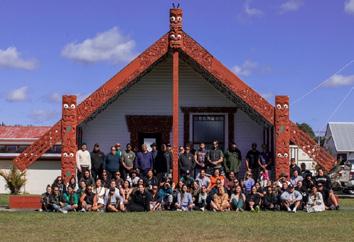

Hosted by the Ministry for the Environment, Te Mana o Te Wai Conference provided opportunity for tangata whenua freshwater management projects to come together to share our respective project activities.
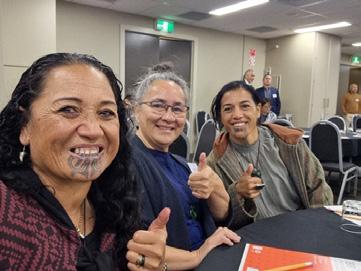

Tēnā koutou katoa, Nōku te whiwhi ki te kawe mai i tēnei rīpoata,
Embarking on my People and Capability role marked the beginning of an intense learning journey. While I’ve had various leadership roles throughout my career nothing seems to compare with Te Rūnanga o Ngāti Awa. As our Manahautū often says, the highs are great, but the lows are, next level. I suppose this stems from the understanding that this isn’t a typical job, it presents an opportunity to consistently serve my people to the best of my capabilities, each day, for the collective well-being of us all. I do have a deep appreciation for that, so I’d like to begin by extending my acknowledgements to all our dedicated kaimahi who have demonstrated remarkable resilience during this period of institutional transformation. Their unwavering passion, strength, and determination have played a pivotal role in our ongoing journey which hasn’t been without its challenges. Our Tumuaki and Manahautū for their vision and leadership but above all, you the people, the hapū who have entrusted us with the responsibility of achieving the outcomes we all require. Thank you for your support.
This unit was running a large negative deficit. Structural change was happening with new positions, and contracts were being established. Kataraina Monika was hired as PMO manager and through her and the great work by her team this entity is now an outstanding function of Te Rūnanga.
We have recently established a Regional Council Resource dedicated to assiting me in building our operational processes. This aspect of our Rūnanga has proven to be one of the toughest with numerous obstacles to overcome, however, the future is promising.
We’re grateful for the ongoing support we receive from Awanuiārangi, which has been vital. We’ve found ourselves in a favorable position, and Ngaire has admirably embraced the role of IT lead with minimal guidance. Her achievements make us immensely proud, highlighting the opportunities our whānau are capable of seizing.
Our communications team has significantly enhanced our visibility among Iwi members, a critical aspect that needed improvement. Karla, Maria and Rere have been valuable additions to our team. We anticipate the communications team’s support for all our funded projects, as well as local council initiatives.
Strengthening Cultural Identity and Connection continues. Rautaki Reorua in conjunction with Local Councils enhances the mana/status of Te Reo Māori within Ngāti Awa boundaries. Archiving and Storage information and how to safely put away archives safely has been collated by staff. Safeguarding data sovereignty is another crucial consideration.
Our Pou has admirably embraced the formidable task of bridging the gap between hapū and the local, national communities. We couldn’t have foreseen the sheer magnitude and busyness that this role would entail. I am sure you will all agree that Mike has been a Pou not only for Te Rūnanga but also for Ngāti Awa.
The primary concern upon my arrival was the substantial financial deficit in Trona. Reuben has assigned all managers the responsibility to align budgets and review each transaction meticulously. This didn’t imply a halt in our operations but rather the implementation of a check system to detect any irregularities. As a result, we managed to significantly reduce the deficit much closer to a neutral position. Gratitude to Stuart and the finance team for their invaluable support, along with all the managers who contributed to making this achievement possible. Kia ora tātau
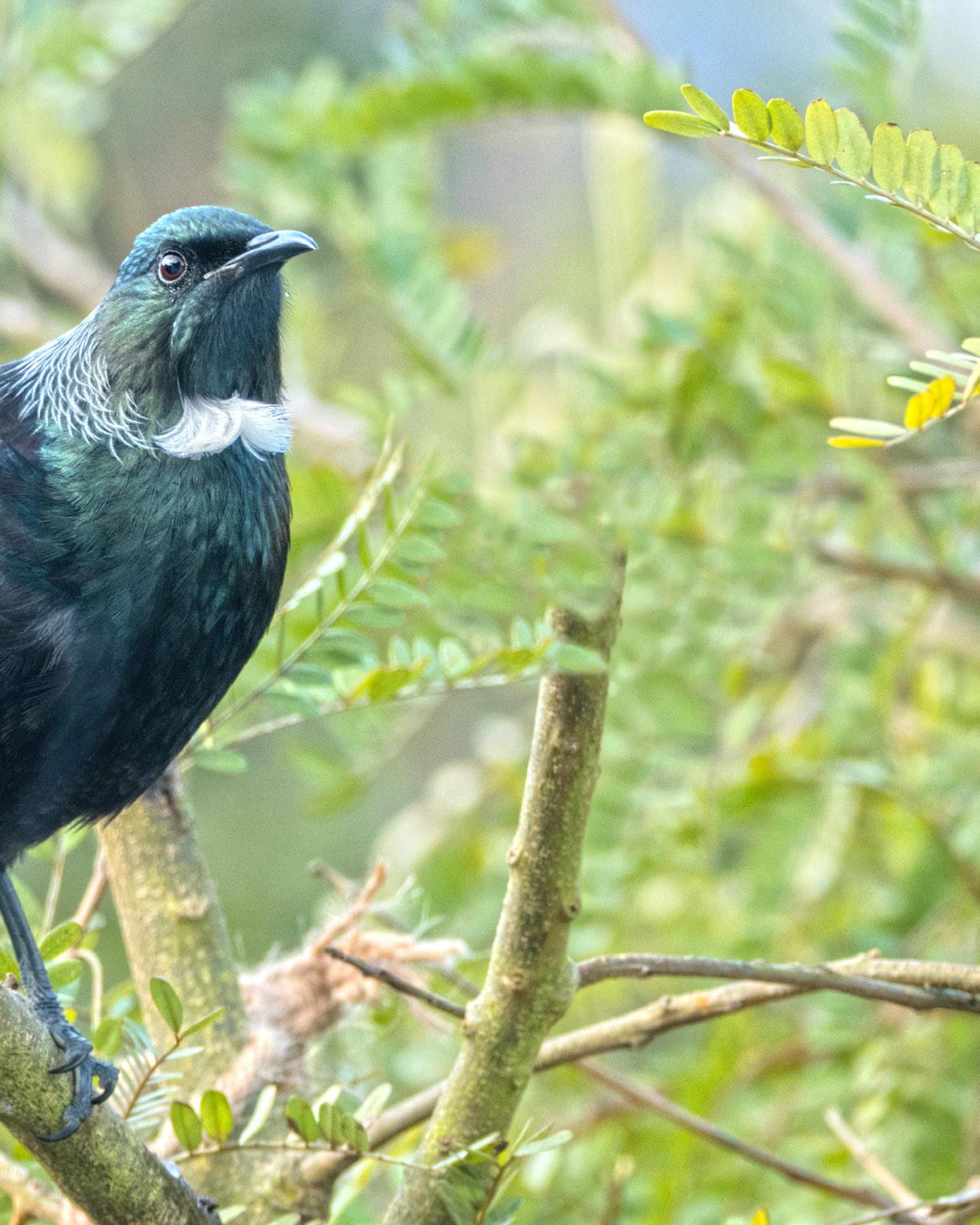

OUR MAHI
“Mahia te mahi, hei painga mo te iwi”
Taihuringa department previously Project Management Office are responsible for managing some of the externally funded projects that contribute to the overarching aspirations of ‘Ko Ngāti Awa te toki’ 2050 vision, through investing in our people as our greatest resource. All Taihuringa projects have had a core focus on uplifting the capabilities of ngā uri o Ngāti Awa through sustainable training and employment opportunities and supporting the Ngāti Awa economy. This is what we continue to focus on through our current projects, which are
1 Te Ara Mahi Project (MBIE Funded)
2 Engagement Project (MSD Funded)
3 Workplace Literacy & Numeracy Project (TEC Funded)
4 Matariki Whakapiri Event
5 Ngāti Awa Waitangi Commemoration Event
In 2022, our team went through a series of changes which included identifying a name for our department instead of Project Management Office. Through understanding what we do and our focus on supporting our people we got ‘Taihuringa’ - Tai referencing the tides and/or a direction and Huringa meaning change. Through our mahi we have experienced people impacted by positive change and enabled to achieve their direction and aspirations. With this name in place, we intend to continue fulfilling its meaning.

PROJECT MISSION: “To create sustainable training to employment opportunities and pathways for Ngāti Awa and local whānau”
This project has been operating for approximately three years now under the management of the Taihuringa department with the two key components being 1. Marine Training and 2. Workforce Development. With the project set to end in 2025, our project objectives and mission are progressing greatly within the set timeframe and budget which has provided us the flexibility to adapt into other training and employment opportunities to ensure our people are work ready and better prepared to reach their achievements.
With marine specific training being a core focus for this project, we still recognise that other trainings are necessary to cater towards the different employment pathways that our people are seeking. See below a full list of the trainings that we have provided this past year in collaboration with training providers such as MAST Academy, Toi Ohomai, and Vertical Horizonz. As part of our training focus, we have also been participating in the following training consortiums to ensure Te Rūnanga O Ngāti Awa representation is present and feed into our framework.
• Te Ara Poutama Māori and Pacifica Trades Training (MPTT) Consortium – hosted by Toi Ohomai
• Reginal Futures Academy Consortium – hosted by Bay of Plenty Futures Academy
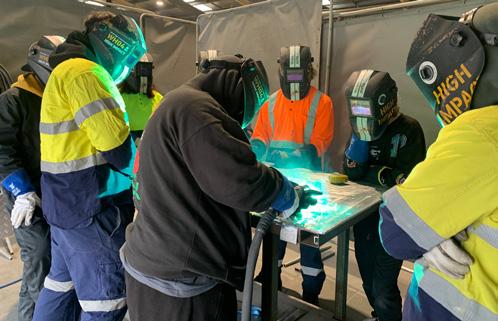
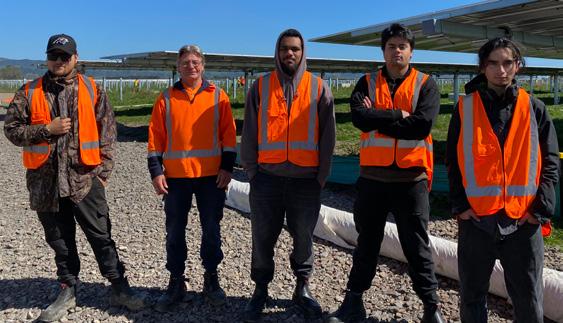
The workforce development component focuses on the full cycle of wrap-around support we provide to get our uri into sustainable employment pathways. Firstly, engaging with our local referrers such as whanau, social services, schools/BOPFA, MSD and others
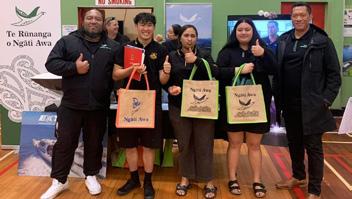
then liasing with various training providers for specific industry training, micro credentials, and pre-apprenticeships to be better work ready.
Lastly creating relationships with local and Ngāti Awa businesses/

This year our local boat building industries have experienced their own challenges as an effect of the international covid-19 impacts. Due to this Extreme Boats were not able to take on as many apprentices as we initially planned which was challenging as our main training program was targeted to that employment pathway, our students were interested in that avenue, and it affected our project objectives.
The halt of the boat harbour project has provided a few challenges as this project was closely connected to that one in terms of marine employment pathways and a training centre. Due to this we have had less marine employment pathways than anticipated and had to continue utilising Extreme Boats facilities to hold our practical trainings.
industries to pathway our people into, while also providing work-readiness support such as CVs, interviews, teamwork, communication workshops and more.

To mitigate this challenge, we started to look at alternative employment options that can still be connected to the Ahei marine training provided such as engineering and welding pathways. Due to this we continue to engage and expand our connections with various local industries to ensure we can support our tauira into the workforce.
To mitigate these challenges, we have
1 Expanded our training and workforce portfolio
2 Continue a great working relationship with Extreme Boats to continue using their facilities
3 Engage with our Ngāti Awa pakihi to feed into our potential work streams
“He aha te mea nui o te ao? He tāngata, He tāngata, He tāngata.
Our people are important to us, and this past year there have been many reasons to celebrate them. One of these occasions was at the first Ahei Marine Graduation held in June, where we celebrated 18 graduates with whanau, hapori, iwi and our various partners.
Our programs are open to all ages however it is predominantly rangatahi. As our next leaders we have the opportunity to engage and develop so many of our next leaders through our training programs, work placements, career expo’s, site visits and so much more through this project. Being closely connected to our people and fostering their journeys despite our challenges continue to be everyday highlights for us.
This past year has shown us how effective a full wrap-around workforce development framework is to ensure our uri come out greatly prepared for training and workforce opportunities. While we continue to improve on our processes and operations, we have a project that is successfully uplifting the capabilities of ngā uri o Ngāti Awa. This is directly supporting our Iwi vision of strengthening our people to have ‘self-determined futures’ and become our next leaders.
We asked two Ngāti Awa uri who participated in our framework how this has supported their aspirations.
“Being able to list my credits and certain papers shows I actually have an edge on randoms plucked off the street. The course also helped me see how a workshop functions and what is expected in the workplace, managed my expectations like I’m not going to jump straight on the welder and be a tradie straight away, I’m still sweeping floors and passing tools”
(Faith McKenzie, Age 21, Ngāti Awa/Ngāi Tūhoe)
“The course helped me secure a career not just a job with my chosen preferred company, there were no vacancies at the time but yous kept following up with me and the employer consistently to ensure the next vacancy belonged to me! Sure, enough the very next opening in the paint shop I gained employment. “
(Tohu Hanlen, Age 19, Ngāti Awa/ Ngāi Tūhoe)

In 2022, Taihuringa department were successful in their application for the Workforce Development Engagement fund through Ministry of Social Development (MSD).
The purpose of the funding Is to support Ngāti Awa uri referred from Work and Income into training and/or employment opportunities by developing and implementing
Total Outcomes (Examples below) Jun 22 – Jul 23
Enable the appointment of an Engagement officer for 12 months
The implementation of a Te Rūnanga O Ngāti Awa WFD engagement strategy
Prepare & Support 30 people into employment during the Term of this agreement
ACTIVITY
Engagement with Te Puni Kokiri
Held a Māori business progressive procurement event with TPK
Engaging and registering Ngāti Awa pakihi
Supporting Ngāti Awa pakihi
Taihuringa 10-day Entrepreneurial wānanga with Rebel Business School Aotearoa
Engaging with external local employers
an engagement strategy. As part of this role, we have been actively engaging with our Ngāti Awa Pakihi as potential employers.
EXPLANATION
As our government entity for Māori businesses, we have been engaging with them to assist with upskilling our pakihi and bridging their internal gaps
• 25 attendees with pakihi ranging from earthworks, civil construction, retailers, consultancy and more
• 9 pakihi have registered to our directory within this financial year. This is an ongoing goal to reach as many Ngāti Awa business owners as we can.
• Provided free venue for activities
• Matariki Whakapiri
• Comms/Marketing support
• Application/proposal support
• Upskilling/training support
• 29 attendees with pakihi ranging from kakahu, printing, kai, contracting and more
Obtaining and negotiating employment opportunities for our trainees and referrals.
Previously there hasn’t been a close working relationship with our local and regional Ministry of Social Development (MSD) branch which provided some challenges. Through creating a positive working relationship with MSD, we have created empowering relationships with our points of contact within the regional office who understand the importance of iwi māori looking after their own uri. The goal is to continue to keep the doors open to our whānau who are struggling to find suitable mahi, creating a safe space for them to come and talk through their goals and aspirations and assist them getting there.
1 Engagement with our Ngāti Awa Pakihi, learning about their business operations, and determining how our Rūnanga can assist with their internal business gaps.
2 Developing trust with our whānau/referrals. This has been one of the most rewarding aspects of this mahi. A lot of our referrals had never been in Ngāti Awa House before, so for them to come through and be welcomed by kaimahi such as Adrian Jaram who can swiftly connect them to those whanau are on our walls and forge a real connection to our whare has been the highlight.

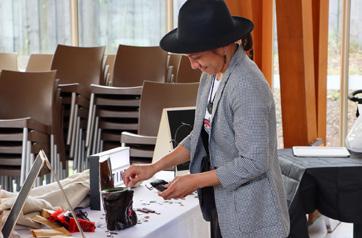

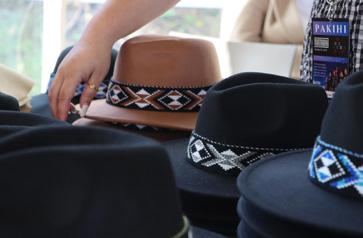
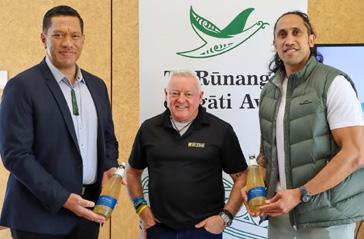
Through this project we have engaged and assisted many of our Ngāti Awa uri through achieving their own aspirations of upskilling, employment and/or pakihi support. Some have attended our 10-day Entrepreneurial wānanga in 2022 with an idea and passion, then grown that into an operating business that contributes to the aspirations of their whanau and future.
This project has shown us how necessary and effective it is to work alongside MSD and our whanau to ensure they’re aspirations are successfully cultivated. It has also demonstrated that we need to continue operations and partnerships like this to progress the focus of ‘fostering the next generation of iwi leaders’ as highlighted in Te Ara Poutama o Ngāti Awa.

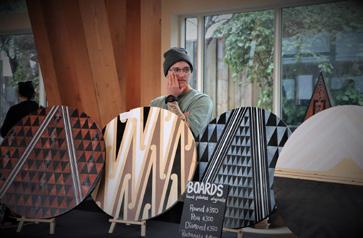

In 2022, Taihuringa in partnership with New Zealand Academic Learning Institute (NZALI) were successful in their application for the Employer-led Workplace Literacy and Numeracy fund through Tertiary Education Commission (TEC). The purpose of this funding is to upskill
the capabilities within our kaimahi and support workplace productivity by providing literacy and numeracy programmes within the workplace.
In 2023, we re-engaged with NZALI to firstly establish the scope and capacities within Te Rūnanga O Ngāti Awa kaimahi so that they
could design, develop, and deliver literacy and numeracy programmes specific to those departments. This project has another 6 months to completion and is currently tracking well with 21 kaimahi registered and 3 programmes designed.
2-hour workshops to support the implementation of the WFD framework, enhance teamwork and cohesiveness.
6x 1-hour sessions to support soft skills development such as communication, teamwork, self-management and more. Korehaha Whakahau
3x full day wānanga to complete the level 2 digital literacy & numeracy programme.
We initially faced challenges with finding the time capacity within our kaimahi to complete a program. However, with the flexibility of NZALI to design a program specific to the needs of our organisation we were able to receive interest from management.
The highlight from receiving this funding and implementing these programs are seeing the growth and confidence cultivated within our kaimahi and students as these programs include components around teamwork, selfawareness, and communication. As these progress, we look forward to seeing the upskilling and professional development across our organisation continue. The greater capability our kaimahi have the better suited we as Te Rūnanga O Ngāti Awa are to achieve the aspirations of ngā uri o Ngāti Awa.
Akohia te tikanga, ka ako. Akohia te pono, kia mārama. Akohia te pūrākau, kia maumahara e whakairo te rawatia i te ngakau a kia tū anō.
Teach me the facts and I’ll understand. Teach me the truth and I’ll understand. Tell me a story and I’ll remember it forever in my heart.
On Friday 16 June 2023, Te Rūnanga o Ngāti Awa hosted a commemoration of the signing of Te Tiriti o Waitangi at Te Whare Wānanga o Awanuiārangi. This year, it had been one hundred and eighty-three years since 12 rangatira of Ngāti Awa and Ngāti Pūkeko signed Te Tiriti. The Rangatira which we remembered were:
Tautari
Mōkai
Mōkai (II)
Mato
Tarawhatiwhati
Tūnui


The purpose of this year’s commemoration was to secure the date of June 16, 1840, and its story in the hearts of Ngāti Awa and our hapori. The invitation to the event was extended to all uri of Ngāti Awa, and all local kura with Te Kura o Te Ōrini, Edgecumbe College, Te Kura o Te Pāroa and Whakatāne High School attending with selected students. Whakatāne District Council, and Te Whare Wānanga o Awanuiārangi kaimahi also attended.
The day consisted of korero by our guest speakers Jasmyn Pearson Ngati Awa roia, and Mataatua academic Taiarahia Black, kapa haka performances from our kura, and Kahoot interactive learning games based around Te Tiriti o Waitangi.
The commemoration day was an unequivocal success, from witnessing our rangatahi and kaumatua connecting over a game of kahoot, to the empowering korero from our guest speakers, and delicious kai from Pukeko caterers, every aspect of the event came together seamlessly. We look forward to building on this significant day and creating more memorable acknowledgements to our Rangatira in the future.
Thank you to everyone who contributed to bringing this day together.

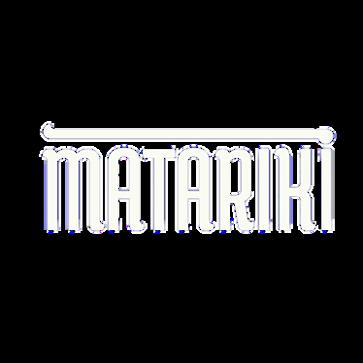






Education and awareness of Matariki
Uniting local iwi, hauora services and pakihi
Exposure for, and collaboration with, Ngāti Awa registered pakihi
Awareness and exposure of TRONA and its projects to the wider community
Whakapiri is about connecting and in this event, it is about connecting to our people and our culture
NB: All objectives met



After the rush of activity in the rohe in preparation for Te Toki in October, Te Toka Tū Haumaru (TTTH) team focus for November was supporting registrations at the TRONA AGM and renewing contracts past the December close date for the four Tīeke.
The Rongoa/Mirimiri Day was also a highlight. This event offered kaimahi and whānau in the rohe o Ngāti Awa affected by COVID, a place, time, and space to heal. Huge thanks to Ngā Tohunga o te Moana a Toi for supporting the kaupapa.
TRONA Iwi register was updated [530] including various key priorities over the period of 1 July to 1 December 2022;
• Correct contact details (member ID, contact type, legal names, birthdate gender, primary hapū & associated hapū) – [data cleanse 2857]
• Te Reo levels [208 Basic, 75 Fluent, 31 Intermediate, 95 Nil; from a total of 409]
• COVID vaccination status, [176 Booster, 103 Vac2, 0 Vac1, 62 No Vac] COVID infected status, support for COVID contact members in this period were significantly lower for this period [40 clinical & food pax issued], limited support from providers except for local community support group Have a Heart Foundation.
Data was gathered but analysis for the following is unavailable in the summary;
• Housing
• Employment/Education
• Health and Wellbeing (long-term illness, disabilities)
• COVID contacts
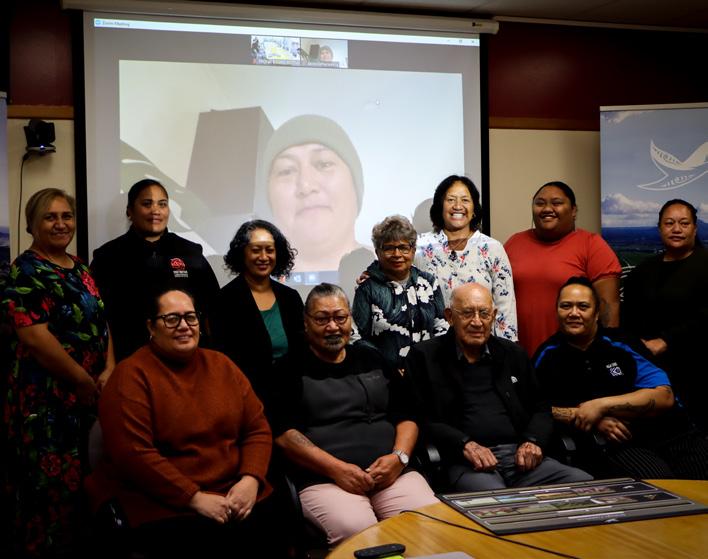
Te Manu Hau and Te Manu Huruhuru contracts ended on 16 December 2022. We worked closely with the PMO team to ensure the Tīeke roles continue until 31 January 2023. Provisions are in place for Tīeke to move into similar employment collecting data with Statistics NZ for the 2023 census. Contracts for the four Tīeke await final sign-off by the Manahautū at the writing of this report. The PMO team under direction from the Manahautū will seek funding in the new year to continue the project activities. Tā Hirini is also keen to have TTTH activities integrated into standard TRONA operations. Folders with TTTH undertakings and spending are in the locked cabinet in Mumuhou (the pod at TMT).
In closing, the pilot of TTTH under the guidance of Tā Hirini has been an exciting project to spearhead. Updating the registrations, encouraging uri of Ngāti Awa to register, and gathering data are integral in TRONA decision-making. It will be interesting to see how TTTH develops in the future.
VICKI MURRAY
Te Manu kaiwhakahaere

E kaha akiaki nei a Aotearoa Reorua kia reorua ngā tāone huri noa i Aotearoa
Ko tā ngā Kaunihera me ngā mana whenua o tēnā takiwā. Ko tēnā whaihua he mahitahi kia whanakehia tētahi rautaki reorua hei whai mā tēnā mā tēnā, e maha ake ai ngā wāhi e kōrerohia ai, e rongona ai, whakanuia hoki ai te reo Māori me te reo Pākeha.
Anei ētahi whakaahua hei tauira. E mahi tahi Te Rūnanga o Ngāti Awa me te Kaunihera o Whakatāne kia reorua a Whakatāne.

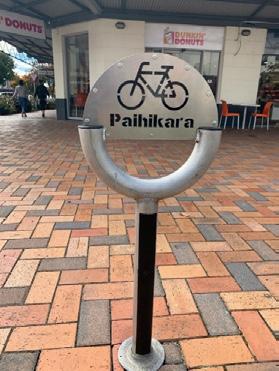
Examples only of some signage being employed in different towns.

learn from the experiences of accomplished champions of te reo Whānau from the various regions ngā toa o te reo Māori o ngā pito e whā, o ngā motu e rua who have turned their commitment and dedication to the revitalisation of te reo Māori into successful careers.
Me mihi ka tika ki a Ngāti Kahungunu Iwi e hiamo ana ki te pōhiri anō ki te motu ki “Te Reo ki Tua! Hui Whakarauora Reo Māori ā-Motu “National Māori Language Revitalisation Symposium.
The workshop’s primary emphasis was on strengthening our iwi through enhancing:
1 Cultural Responsiveness
2 Cultural Intelligence
3 Cultural Competency
Through role-playing and interactive exercises, the facilitator employed a comprehensive and multi-faceted approach. At times, the workshop prompted deep reflection, fostering a profound comprehension of our history and the enduring impact of colonisation on our people’s perspectives, attitudes and our tikanga extending to the present day.
The workshop was made available for both hapū delegates and staff and came highly recommended, especially for those individuals with only have a cursory knowledge of our culture and history.
Developing new resources that observe our traditions, customs, and places of special significance
Ko te tuatahi kia maumahara mātau ki a Ngamihi Norma Crapp (Ētita), rāua ko Te Kei o te Waka Merito (Nānā te rauemi i tapa). E tangi hotuhotu tonu ana te manawa ki a rāua.
I whakarewangia e tō mātau tari o Te Rūnanga o Ngāti Awa he rauemi mā ngā pia o te reo ōkawa, o te reo karanga i te hui a tau i 2022.
He tauira urupare i te reo karanga ō manuhiri ki ngā marae o Ngāti Awa.
First and foremost, to pay tribute to the late Ngamihi Crapp and Te Kei o te Waka Merito, both of whom made valuable contributions to this resource and sadly passed this year.
During the 2022 AGM Annual General Meeting, the Identity, Language and Culture division of Te Rūnanga o Ngāti Awa shared a hardcopy version of the te reo resource designed for karanga learners.
The templates featured in the karanga resource are intended for general hui and are specifically tailored for visiting kaikaranga demonstrating how one might incorporate tīpuna and whenua names etc when considering a karanga for the hapū o Ngāti Awa.
It is important to note that this resource serves as a fundamental guide and is not a substitute for the teachings that you may receive from your respective hapū pūkenga (knowledge holders).
Visit our website for the flipbook version with audio explanations and karanga examples that we released during Māhuru Māori.
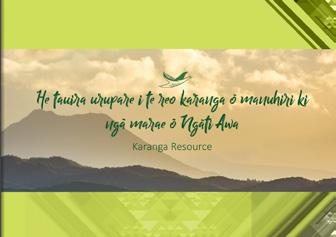


Whaikōrero & Karanga Wānanga Ahakoa ngā āhuatanga o te rā ka haere tonu ngā wānanga. I hia kē ngā wānanga i tū e tō mātau tari kia awhina ai te i te iwi.
Ngā māreikura a Matariki, whakaniko ki Ngāti Awa was an exhibition that brought together for the first time a collection of Ngāti Awa wāhine whose works drew on on tribal customs, values, and connections to the Pacific.
Some of the works and their narratives debunk the colonial influenced view on what roles and art Māori women can perform.
A collection of fifty artworks was presented, showcasing a rich variety of artistic expressions. The exhibition provided a stage for emerging artists, including those who publicly displayed their work for the first time, to share the spotlight with renowned established artists, among them Dame Robin White, Margaret Belshaw, Sarah Hudson, Glenda Hape and Erena Koopu, to mention just a few, who artistic achievements resonate on the international stage.
Three main themes were interwoven within the artworks; Matariki, He mana tō te wāhine, and Te Tahi o Te Rangi. The design overlay (Te uha o te wāhine) for the booklet right and exhibition was created by Sarah Hudson.


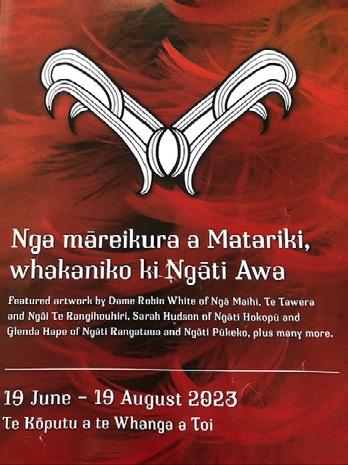



This year highlights the transformative impact of new leadership and their vision of growth for Te Mānuka Tūtahi Marae. We embark on a journey aimed at broadening our influence as a thriving hub for gatherings of significance and establishing ourselves as respected authorities in the conference and events sector.
Over the years Mataatua Wharenui has welcomed visitors from around the world seeking to experience our rich culture, history, and traditions. Tourism has long been seen as a potential source of economic growth and cultural exchange. A comprehensive analysis of the financial performance was conducted and despite our previous efforts to showcase Mataatua Wharenui on a global stage, the decision was made to cease all tourism product delivery from February 2023. This was heavily influenced by a consistent decline in financial viability.
As a result, one of the most significant changes came in the form of job losses as part of a wider strategy to rebuild the maraes financial foundation, realign operations and strengthen the business proposition allowing it to grow into a long-term sustainable venture. Opportunities to reallocate roles into other departments within the organization were made available to the affected staff.
Hosting events is not a new concept for the Te Mānuka Tūtahi Marae. Having operated with basic processes and procedures, the new vision demands a more tactical and measured approach. This transitional period seeks to streamline core aspects of the reset that will serve as foundational pillars of growth over the next 12 months. An operational review is underway to evaluate and enhance our business processes, practices, and efficiency identifying areas where improvements can be made to optimize the way we deliver events. We are analyzing various aspects such as resource allocation, workflow management, communications channels and technological infrastructure while aligning with industry best practice.
Collateral
Our goal is to present a thorough and detailed overview of our marae, including its facilities, services, and amenities. Our promotional material will highlight various layout options, technical capabilities and any special features that distinguish our marae from other conference and event venues. We strive to instill confidence in our clients by showcasing our expertise in providing a culturally authentic experience and the commitment to excellence through our state-of-the-art facility. Additionally, we are creating new hire agreements, customer engagement documentation and communicating our Health and Safety procedures and protocols appropriately.
Our digital Waharoa will focus on versatile venue spaces and customizable packages and services. With a user-friendly interface, captivating visuals, and easy access to booking platforms, the site will ensure a seamless and efficient process for potential clients to explore, connect and present as a prime destination for an immersive and authentic cultural encounter, ultimately choosing our Marae as the ideal setting for Kaupapa Rangatira.
Bespoke Products & Services
Across a diverse range of clients and events of varying significance, a common trend emerged, a market demand for a personalized experience rather than simply hiring a venue. This presents an exciting opportunity to potentially repurpose dormant aspects of our tourism offerings such as the light show, Mataatua Wharenui history presentations and historical walks as they have become popular requests. Additionally, we have the capability to relieve clients of the burden of complex event planning by providing a range of independent services. In the forthcoming year, our intention is to introduce bespoke packages that align with the growing demands of our clients and visitors.


We have undertaken significant improvements to our health and safety practices and protocols. An increase in visitor activity, and the high demand for customised services means it is essential that we are consistently adapting, measuring, and improving our service delivery to ensure events are conducted responsibly. There is a collaboration with the overall organizational Health and Safety department to ensure marae wellbeing and the safety of our visitors align with Te Runanga o Ngati Awa values and industry best practice.
The rates review reflects the increasing costs associated with hosting events, ensuring potential losses are avoided while maintaining pricing benchmarks within the industry. Customised packages are being developed to cater for the increasing demand for boutique experiences as additional product offerings.
Caterers can now access the commercial kitchen for a fee in accordance with the established hire rates. This allows them to provide their services directly with the client where previously the marae absorbed these costs without charge. Furthermore, caterers now have the flexibility to access the kitchen for their own business needs beyond event services.
The next 12 months are dedicated to the transformation of Te Mānuka Tūtahi Marae as established leaders in the conference and events space. We are actively committed to fully realizing the new vision, setting new standards, and delivering exceptional experiences for all visitors to Te Mānuka Tūtahi marae and Mataatua Wharenui.


It is my pleasure to report the results for Ngāti Awa Group (Ngāti Awa Group Holdings Limited and Ngāti Awa Asset Holdings Limited together herein referred to as the “Group”).
We transitioned through a year where economic volatility saw several negative impacts including the equity markets experiencing large losses, and interest rates almost doubling. The effect was significant however the markets have since rallied, and the losses have almost fully recovered.
As inter-generational investors, we know that strategic investment is a long game that will provide consistent and secure returns over time. The market volatility experienced in FY23 has confirmed the need to build a diversified, resilient portfolio that can withstand the unexpected and diversify our risks.
The board constantly reviews our whenua assets in compliance with the Whenua Policy. We are building assets that will generate cash earnings with the development of Ōmataroa Orchard - a 10-hectare conversion of dairy farmland into a Ruby Red kiwifruit orchard. This investment will produce returns that will reap benefits through harvest from FY25 onwards.
More detail is provided on the financial results in the CEO report, suffice to say, that a net profit of $4.7 million represents a total portfolio return on invested assets of 3%, a stable result given the unstable economy.
The board assesses deliverables as set out in our Strategic Plan –Mahere Rautaki 2021 - 2025 and encompassed in the whakataukī:
Kia whakanui i ngā rawa o ngā mahi ōhanga hei painga mō ngā iwi o Ngāti Awa
To sustainably maximise economic benefits for the people of Ngāti Awa
We also acknowledge that there are several key imperatives outside of financial targets that must be achieved to support hapū growth.
Our Strategic Plan applies a wide interpretation of economic benefits to encompass the general wellbeing of ngā uri ō Ngāti Awa. We have established key strategic objectives that align with our five pou:
Kia whakanui i ngā rawa o ngā mahi
hei painga mō ngā iwi o Ngāti Awa
• Kaitiakitanga (high performing portfolio);
• Ngāti Awatanga (supporting TRONA outcomes);
• Kotahitanga (high performing organisation);
• Whanaungatanga (effective relationships); and,
• Manaakitanga (sustainability).
We continue to work closely with our sole shareholder, Te Rūnanga o Ngāti Awa (TRONA) to align long-term strategies and provide input in to the TRONA 2023 Strategy Review.
The board recognises the need to deliver a growing and sustainable dividend to the shareholder without eroding the investment value of the portfolio. This means we must ensure that the directors of the Group must meet their fiduciary obligations and investment objectives while providing an annual dividend protected against inflationary pressures and volatility. All of which allows TRONA to be in a stronger financial position to meet its wider social and cultural objectives for Ngāti Awa hapū.
During the year a Distribution Policy was recommended and approved by TRONA. The dividend paid will be based on $1.5 million per annum at minimum or 40% of the net operating cash flow. This is an increase from the $1.3 million dividend paid annually in prior years.
We enter FY24 dedicated to growing commercial value with a committed board, and a drive to achieve continued growth over the long term.
We are thankful to have benefited from the skills and professionalism of three Associate Directors: Alecia Wright-Chand, Regan Studer and Wharehuia Dixon, who had been with us over the past three years. Their terms ended in November 2022, and we would like to acknowledge their contribution to our board and committee meetings throughout that time.
We also acknowledge the contribution of retiring independent directors, Debbie Birch and Karl Gradon. Debbie was a long-serving director having been with us since 2014, providing sound investment advice throughout her time. Karl came on board in 2019 and provided guidance and assurance throughout his tenure.
In closing, I take this opportunity to acknowledge TRONA for placing their trust and faith in NAGHL. We are committed to ensuring greater strategic alignment with our shareholder and look forward to working more closely with them in the years ahead.
I also wish to thank the Ngāti Awa Group Holdings CEO, Tracey Hook and our kaimahi for their dedication and commitment over another challenging year, and finally my fellow directors for their professionalism and support.
Nāku iti nei, nā
DR. JIM MATHER
NAGHL Board Chair

It is my pleasure to present this report for the financial year for the period from 1 July 2022 to 30 June 2023 (FY23).
We have achieved a combined net profit of $4.7 million.
Whilst this is a steady result, it reflects the one-off gain from the sale of the Tumurau farm in the previous financial year. The proceeds from the farm sale have since been invested into the development of the Ōmataroa Orchard as part of our long-term growth strategy.
Challenges faced across the agriculture sector had some negative impacts on our operations. This included the decrease in the milk payout rate and an unusually wet season affecting dairy revenue. While we were able to re-fix interest rates on debt the overall cost of borrowing has increased globally and will continue to have an impact.
We enjoy a strong, long-term relationship with our main banking partner ANZ. This partnership, now in its third decade, will continue to be of strategic importance as bank lending will remain critical to our strategic plans for investment and growth. We have also recently forged a successful partnership with Westpac who are set to provide the funding for the Ōmataroa Orchard development.
It is important to note that our combined operating cash flows of $1.2 million are positive. This is a crucial indicator that our baseline operations are not diminishing cash.
Our combined asset and equity value is also heading in the right direction, growing on prior years results by 8% and 1% respectively.
Payments to our sole shareholder, Te Rūnanga o Ngāti Awa (TRONA) totaled $2.3 million (FY22: $2.4 million).
This is comprised of; dividend ($1.4 million), interest ($0.4 million) and loan repayment ($0.5 million). This provided sufficient cash for TRONA to meet its operational needs.
Ngāti Awatanga | Achieve the Ngāti Awa Vision
At Ngāti Awa we support pakihi by providing opportunities and support for businesses to flourish.
BlinkPay, the first Māori-owned fintech company, is one of the first beneficiaries of this support with an investment of $1 million approved by our board following a rigorous investment screening and due diligence process.
BlinkPay was founded by the late Daniel Karehana (Ngāti Awa) and enables payment of all bills in one single application with minimal clicks and a direct link between the bill payer and banks.

Ōmataroa Orchard
The group’s strategic objective is to achieve a high-performance portfolio. We constantly monitor the performance of underlying assets and investments and always seek to optimise investment performance.
Among the group’s assets is our dairy land located just north of Te Teko adjacent to the Rangitaiki River. This land was identified as a prime location for growing kiwifruit and as such 10.4 hectares has been converted from dairy into a red kiwifruit orchard – currently the largest Māori owned red kiwifruit orchard in Aotearoa.
The development was named Ōmataroa Orchard and is owned in partnership with Ihukatia Trust, Moerangi Kereua Ratahi Trust, Kiwinui Trust and Ngāti Awa Farms Limited. Southern Cross Hort were selected through a tender process to develop and establish the orchard.
Planted in January 2023, the first harvest is expected in March 2025.

We pride ourselves in having high-performing assets that are recognised as the best in class.
This year Awa Motel in Whakatāne was successful in winning the Best Motel over 25 rooms category at the national Hospitality Awards for Excellence 2023. We also received the Qualmark Gold Certification for Sustainable Tourism Business Award, an improvement from the previous silver certification, making us one of only 16 motels in Aotearoa to receive top level certification.
The motel continues to go from strength to strength in both profitability and occupancy thanks to our strong values and commitment to manaakitanga and kaitiakitanga.
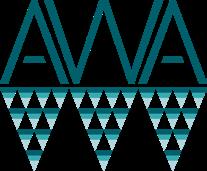

We have ambitious plans to re-develop the Strand on the site where the former Army Hall was located. Partially funded by Kānoa we have procured conceptual designs for a fully re-locatable building that can be moved to higher ground in the event of adverse weather events. In planning the construction, the innovative design is intended to future-proof the building, demonstrating our strong commitment to addressing the future impacts of climate change.
The facility will provide a café, with private dining/board room, meeting venue, a tourism hub and event venue capable of seating up to 120 guests for weddings, conferences and special events. It will also include a biosecurity facility to process manuhiri planning to tour the Moutohorā Island Sanctuary. We expect consents to be delivered over the coming months and building to commence in the first quarter of 2024, with completion anticipated early in 2025.

I would like to express my sincere appreciation and thanks to the NAGHL Board who have guided the company through unprecedented challenges over the last four years. Having an intentionally diversified and resilient portfolio has protected the iwi assets from being exposed to negative volatility in any one sector. The business is well set to grow over the coming years.
I also want to acknowledge and show my sincere appreciation to our hardworking NAGHL kaimahi who are loyal, dedicated, and driven to deliver value and grow the putea for the benefit of our Ngāti Awa uri and mokopuna. It has been my privilege to have worked with a group of professionals who are committed to advancing the aspirations of Ngāti Awa.
TRACEY HOOK Chief Executive

Paul grew up on a farm in the Hawkes Bay and obtained a Bachelor Ag Comm (Economics) from Lincoln University.
A previous Member of Parliament (2008- 2011) Paul has worked at the Reserve Bank of New Zealand, and has previous executive roles in New Zealand Forest Industry Council, Tranz Rail Limited, and Māori Business Facilitation Services.
Paul previous directorships in recent years included GNS, AsureQuality, NZRU (Deputy Chair), Community Trust of Wellington (Trustee) and New Zealand – United States Educational Foundation (“Fullbright”) and he holds current governance roles with:
• MoCoM Holdings
• Ngāti Awa Farms Limited
• Ngāti Awa Audit Finance & Risk Committee
• White Island Tours Limited
• Mātai Pacific Iwi Collective LP
• Te Puia Tapapa GP Limited


Ngāti Awa, Ngai Tuhoe, Ngāi Tai, Whakatohea

Appointed to the Board in 2018, Jim has held Chief Executive roles at Te Wananga o Aotearoa, Māori Television, and the Pacific Business Trust and is also the Chair of the Health and Safety Committee. Having completed a PhD in Māori Economic Development, Jim also has a Master of Business Administration from the Henley Business School in England and a Bachelor of Business Studies.
Jim is a Chartered Accountant and Chartered Fellow of the NZ Institute of Directors. He also founded a specialist Māori Development consultancy in 2018.
He currently holds governance roles with the following organisations:
• Chair of Radio New Zealand
• Chair of InZone Education Foundation
• Director of Southbase Construction Limited
• lndependent Director of Tonkin + Taylor
• Member of Te Puni Kokiri Audit & Risk Management Committee
• National Council Member of the Institute of Directors
• Auckland Branch Committee Member of the Institute of Directors
• Member of the OCS New Zeland Advisory Group
• Member of the Hauora Māori Advisory Committee
Appointed to the Board in 2014, Heta is a Director of Kākano Advisory Limited, a Māori owned accounting and advisory practice working with whanau-owned pakihi as well as Māori land trusts and iwi organisations.
He has a Bachelor of Law and currently holds governance roles with the following organisations:
• Chair of Whāriki Māori Business Network
• Trustee on the Poutama Trust
• Director of Manaaki Law Limited
• Director of Blink Pay Global Group Limited
Proudly from Te Teko, Tiaki brings a wide range of skills and experiences from both executive and governance roles across Iwi, Māori, Government and Corporate sectors. Having previously been both General Manager and a Director of NAGHL, he has also held senior executive leadership roles within Te Tumu Paeroa, Fonterra and currently as CEO of Māori Investments Limited.
Tiaki’s goverance experience covers a wide range of Māori economic development, iwi collaboration, and primary industries. He has a Bachelor of Law and a Bachlor of Arts and has completed executive leadership development with the Institutes of Directors and Stanford University.
• Trustees on the Putauaki Trust
• Director of Tarawera Land Company
• Director of Waiu Dairy
• Member on the Zespri Sustainability Advisory Board




Ngāti Tuwharetoa, Ngāti Apa, Ngāti Hauiti, Raukawa ki te Tonga, Ngāti Rangi (left 20 Feb 23)
Appointed to the Board in 2018, Kiriwaitingi is the current Chief Executive Officer of Māori Investments Limited.
Kiriwaitingi has a Bachelor of Law degree, Bachelor of Social Science, Bachelor Arts (Honours). Having previously practiced as a lawyer, she has also held senior leadership roles for Te Arawa Group Holdings Limited and Te Arawa River lwi Trust.
Kiriwaitingi holds governance roles with the following organisations:
• Head of Māori Alliances at Zespri
• Facilitator at NZ Institute of Director
• Chair of Putauaki Trust
• Director at Scion
Victoria was appointed in 2020 and is also Chair of Ngati Awa The Strand Development Limited. Victoria’s husband and sons are of Ngati Awa descent. With over 20 years’ experience as a company director she has previously held governance roles with Jucy Group, Tax Management NZ, NZ Thoroughbred Racing, Best Start, Turners Auctions, Auckland Kindergarten Association.
An entrepreneur, Victoria founded New Zealand’s first car share business, Cityhop. A former Auckland City Councillor, she was behind the re-starting of the Auckland Arts Festival.
She has received a ONZM for services to the arts, business and community Victoria is a Chartered Fellow of the NZ Institute of Directors and has a Bachelor of Laws.
Victoria currently holds governance roles with:
• Waka Kotahi (NZTA) (Director)
• Waka Kotahi (NZTA) Chair of People and Culture Committee, and Audit and Risk member)
• Auckland Eye
• Auckland Regional Amenities Funding Board
• Mrs Mac’s New Zealand Limited
Debbie was appointed in December 2014 and is also the Chair of the Investment Committee.
Debbie has significant financial, commercial, and strategic experience gained in Asia, Australia and New Zealand with more than 30 years working in global capital markets, and currently holds governance roles in:
• Eastland Group Ltd and subsidiaries
• Raukawa kite Tonga AHC Limited (Chair)
• Taupo Moana Investments Ltd (!WI investor)(Chair)
She is also a member of Treasury Capital Markets Committee, Te Puna Whakaaronui Thought Leaders Group and is a Trustee of Wellington Free Ambulance Trust, Manu Rere Charitable Trust and Otaahuhu Charitable Trust.
Appointed to the Board in 2019, Karl is currently CEO of the largest Māori exporter, Miraka, and resides in Ohope. Having spent most of his career off shore in Brasil, USA, France and Singapore. Karl has held various leadership, economic development, and advisory roles since returning to aotearoa.
With a Bachelor of Science, Karl holds several governance roles in the agricultural and agritech areas.

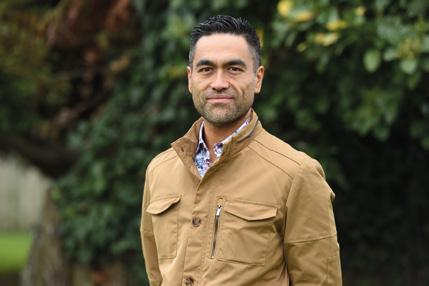
Associate Director, Ngāti Awa, left 23 Nov 22
Appointed to the Board in 2019, Alecia is . a Manager of Accounting Services at Fonterra. She was previously at Deloitte and has over ten years’ experience in assurance and advisory.
As a qualified Chartered Accountant Alecia also holds a governance role with the Waikato branch of Chartered Accountants Australia New Zealand as a local committee member.

Associate Director, Ngāti Awa, left 22 Nov 22
Appointed to the board in 2019, Wharehuia is an Associate Civil Engineer at Beca Limited.
Wharehuia has a Bachelor of Engineering (Civil) from the University of Auckland. He also has Te Tahu Pokairua o Te PTnakaitanga ki Te Rea Kairangi and is currently studying towards Te Tahu Paerua o Te Rea Kairangi, both from Te Wananga o Aotearoa.
He pT kua rere, he manu kua auraki mai nei tau ai ki te peka o te hTnau, ki te rae o Te Pahipoto.
Noku te marenganui ki te whai wahi ki waenga i tenei kahui rangatira. He wheako hou tenei ki a ia, me te aha, he huarahi hoki kia pai ai tana hokinga mai ki te kainga.
He raukura tenei no Te Whare Wananga o Tamaki Makaurau, a, kua riro i a ia te tohu o te pukahatanga. Kua tata ki te 15 tau kua takahi i tenei ara, ka mutu kua nui aku wheako e hangai ana ki nga ahuatanga o te whakahoahoa me te whakahaere i nga hinonga me te whakaaro he hua, he pukenga ranei kei oku ringaringa hei painga mo to tatou lwi.
I tua atu i tena, he wawata hoki oku ki te whakarata i a tatou mokopuna tamariki ki te ao pukaha, ki te ao putaiao ano hoki kia whakawhanui ai 6 ratou tirohanga ki 6 ratou pita mata. Ko, ko, koia e ara e!
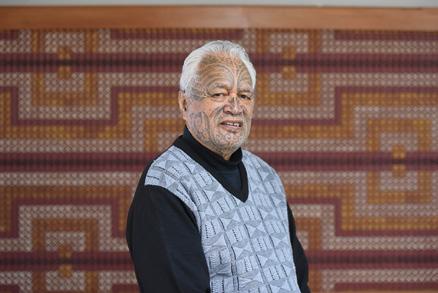
Associate Director, Ngāti Awa, left 22 Nov 23
Appointed to the Board in 2019, Regan’s primary background has been in the agricultural sector where he has personal farming interests. Over the past ten years he has worked with many Māori land trusts and organisations as both trustee and advisor.
Regan holds a Master of Business Administration from Waikato University and a Bachelor or Business Management.
He currently holds the following governance roles:
• Trustee of Te Rea lrirangi o Te Manuka Tutahi (Sun and Tumeke FM)
• Ngati Awa Farms Limited (Director)
• Te Whare Wananga o Awanuiarangi (Finance, Audit and Risk Committee)
Te Rūnanga o Ngāti Awa Chairman, Ex Officio, Ngāti Awa

Te Rūnanga o Ngāti Awa Chairman, Ex Officio, Ngāti Awa

TE RUNANGA O NGATI AWA
Representatives
M Araroa
A Smith
M Kingi
TA Barrett
TW Koopu
S Ratahi
K Mokomoko
TK Merito
L Hepi
Jay Mason
A Morrison
R Shortland
M Dodd
A Mead
M Sisley
M Glen
R O’Brien
W Stewart
P Ngaropo
T O’Brien
C Takotohiwi
B Kingi
THE NGATI AWA COMMUNITY DEVELOPMENT TRUST
Trustees
A Green
T O’Brien
NGATI AWA RESEARCH & ARCHIVES
TRUST
Trustees
S Tutua
A Jaram
P Ngaropo (Chair)
NGATI AWA GROUP HOLDINGS
LIMITED
Directors
J Mather
VM Carter
HW Hudson
K Rei
T Hunia
BP Quinn
NGATI AWA ASSET HOLDINGS
LIMITED
Directors
J Mather
VM Carter
HW Hudson
K Rei
T Hunia
BP Quinn
NGATI AWA FARMS LIMITED
Directors
R Studer
BP Quinn
T Hunia
NGATI AWA FORESTS LIMITED
Directors
H Hudson
BP Quinn
NGATI AWA PROPERTIES LIMITEd
Directors
H Hudson
BP Quinn
NGATI AWA FISHERIES LIMITED
Directors
H Hudson
BP Quinn
WHITE ISLAND TOURS LIMITED
Directors
BP Quinn
NGATI AWA FARMS (RANGITAIKI)
JOINT VENTURE
Joint Venture Partners
Ngati Awa Farms Limited
Ihukatia Trust
Moerangi Kereua Ratahi Lands Trust
Rangitaiki 31P 3F Trust (also known as Kiwinui Trust)
Directors
T Hunia
BP Quinn
R Studer
MANU HOU LIMITED PARTNERSHIP
Limited Partners
Ngati Awa Asset Holdings Limited
Putauaki Trust
Omataroa Rangitaiki No.2 Trust
MANU HOU GP LIMITED
Directors
BP Quinn
C Elliott
H Hudson
TUMURAU LIMITED PARTNERSHIP
Limited Partners
Ngati Awa Farms Limited
Rangitaiki 31P 3F Trust (also known as Kiwinui Trust)
Rotoehu Forest Trust
Moerangi Kereua Ratahi Lands Trust
TUMURAU GP LIMITED
Directors
R Studer
BP Quinn
NGATI AWA THE STRAND DEVELOPMENT LIMITED
PARTNERSHIP
Limited Partners
Ngati Awa Group Holdings Limited
Crown Regional Holdings Limited
NGATI AWA THE STRAND DEVELOPMENT GP LIMITED
Directors
V Carter
P Drummond
T Hook
Te Rūnanga o Ngāti Awa, (TRONA), is an iwi authority1, post-settlement governance entity2 and the representative body3 for 22 hapū of Ngāti Awa of the Whakatāne district. TRONA is committed to serving its people and advancing the well-being of its members.
As a settled iwi4 TRONA holds statutory acknowledgements of its relationships with various natural resources in our rohe for which TRONA and Ngāti Awa Hapū exercise kaitiakitanga.
Clause 2.3 of the Ngāti Awa Charter (last reviewed in 2018) establishes the following ‘Purposes of the Rūnanga’:
The purposes of the Rūnanga are to receive, manage, and administer the Rūnanga’s Assets on trust for the relief of poverty, the advancement of education or religion or any other object or purpose that is beneficial to the Ngāti Awa community and shall include without limitation;
(a) The promotion amongst Ngāti Awa of the educational, spiritual, economic, social, and cultural advancement or well-being of Ngāti Awa and its Hapū;
(b) The maintenance and establishment of places of cultural or spiritual significance to Ngāti Awa;
(c) The promotion amongst Ngāti Awa of mental health and well-being of the aged or those suffering from mental or physical sickness or disability; and
(d) Any other charitable purpose that is beneficial to the Ngāti Awa community.”
This Statement of Service Performance outlines our organization’s dedication to fulfilling our obligations and achieving our purposes.
We are committed to providing high-quality services that align with our values, meet the needs of our community, and contribute to the holistic development of our people.
1 Objective: Ngāti Awatanga
Strengthening Cultural Identity and Connection
• Initiating and supporting cultural events, workshops, and educational programs to promote Ngāti Awa heritage and language.
• Providing resources and guidance to support the revitalization of cultural practices and traditional knowledge.
• Facilitating opportunities for intergenerational connections and sharing of Indigenous knowledge.
2 Objective: Manaakitanga
Enhancing Social Well-being
• Offering support services to improve the physical, mental, and emotional well-being of our community members.
• Collaborating with healthcare providers to ensure access to culturally appropriate healthcare services.
• Promoting social inclusion and reducing disparities by addressing social determinants of health and well-being.
3 Objective: Whai Rawa
Economic Development and Employment Opportunities
• Supporting local entrepreneurship and business development through mentoring, training, and access to funding.
• Facilitating partnerships and collaborations to create sustainable employment opportunities within Ngāti Awa.
• Promoting economic growth that respects our cultural values and traditional practices.
• Measuring and reporting on economic indicators and employment rates within the Ngāti Awa community.
4. Objective: Kaitiakitanga Environmental Stewardship and Sustainability
• Implementing initiatives to protect and restore our natural resources, including land, water, and biodiversity.
• Educating community members about sustainable practices and the importance of environmental sustainability.
• Partnering with government agencies and other stakeholders to advocate for sustainable environmental outcomes.
5. Objective: Effective Governance and Accountability
• Maintaining transparent, accountable, and complying governance structures that uphold the principles of Tikanga Māori.
• Implementing robust financial monitoring and reporting mechanisms to ensure compliance with relevant regulations and standards.
• Continuously reviewing and improving our governance processes based on community feedback and best practices.
Conclusion: Te Rūnanga o Ngāti Awa is dedicated to serving our community and fulfilling our commitments to cultural connectivity, social well-being, economic development, environmental sustainability, and effective governance. We recognize the importance of collaboration, accountability, and continuous improvement in delivering services that meet the evolving needs of our people. By monitoring our performance and seeking community input, we strive to provide the highest quality services and contribute to the holistic development and flourishing of Ngāti Awa.
Hapū Distribution 22 Hapū
Pataka Kai - Beef 18 Beasts 8,413 18 Beasts 8,340
Pataka Kai - Fish 1,300 Kg
Strengthening Cultural Identity and Connection: Initiating and supporting cultural events, workshops, and educational programs to promote Ngāti Awa heritage and language
Strengthening Cultural Identity and Connection: Providing resources and guidance to support the revitalisation of cultural practices and traditional knowledge.
Providing resources and guidance to support the revitalisation of cultural practices and traditional knowledge
Providing resources and guidance to support the revitalisation of cultural practices and traditional knowledge
Economic Development and Employment Opportunities: Promoting economic growth that respects our cultural values and traditional practices.
Environmental Stewardship and Sustainability: Implementing initiatives to protect and restore our natural resources, including land, water, and biodiversity. Educating community members about sustainable practices and the importance of environmental sustainability. Partnering with government agencies and other stakeholders to advocate for sustainable environmental outcomes.
The Board of Directors of Te Rūnanga o Ngāti Awa (Group) authorised these financial statements presented on pages 67 - 94 for issue on 27 October 2023.
For and on behalf of the Board.
T O’Brien
M Glen
Chairman | 27 October 2023 Deputy Chairperson | 27 October 2023
The above statement of financial position should be read in conjuction with the accompanying notes.
1 Statement of accounting policies for the year ended 30 June 2023
1.1 Reporting entity
Te Runanga o Ngati Awa (“the Runanga”) and its subsidiaries (together “the Group”) manage the cultural, social, political and economic base of the Ngati Awa iwi. The Runanga was incorporated under the Te Runanga o Ngati Awa Act 1988, which was subject to the Maori Trust Board Act 1955. Under Section 5 of Te Runanga o Ngati Awa Act 2005, the Runanga ceased to be a Maori Trust Board from 25 March 2005 but continues as the same body as established by the Te Runanga o Ngati Awa Act 1988.
The Runanga is domiciled in New Zealand. The address of the registered office is 10 Louvain Street, Whakatane.
2 Summary of significant accounting policies
The principal accounting policies applied in the preparation of these consolidated financial statements are set out below. These policies have been consistently applied to all the years presented, unless otherwise stated.
2.1 Basis of preparation
The Runanga is a registered charity under the Charities Act 2005 and its financial statements have been prepared in accordance with that Act, the Financial Reporting Act 2013 and as required by the Charter of Te Runanga o Ngati Awa. The Runanga is a public benefit entity (“PBE”) for the purposes of financial reporting. A PBE is an entity whose primary objective is to provide goods or services for community or social benefit and where any equity has been provided with a view of supporting that primary objective rather than for a financial return to equity holders.
The financial statements have been prepared in accordance with New Zealand Generally Accepted Accounting Practice (“NZ GAAP”). The financial statements comply with the PBE Standards Reduced Disclosure Regime (“PBE Standards RDR”) as appropriate for Tier 2 not-for-profit public benefit entities, for which reduced disclosure regime concessions have been applied. The Runanga qualifies for Tier 2 as it has total expenses less than $30 million and does not have public accountability.
The presentation and functional currency is New Zealand Dollars (NZD). The measurement base applied is historical cost, as modified by the revaluation of certain assets and liabilities as identified in these accounting policies.
The Group consists of the Runanga and its subsidiaries, associates and joint ventures as listed in note 24.
The financial statements have been prepared on a going concern basis.
Subsidiaries
Subsidiaries are those entities controlled, directly or indirectly, by the Runanga, that is, the Runanga has the power to govern the financial and operating policies of the entity so as to obtain benefits from their activities. The Runanga consolidated subsidiary companies generally have an accompanying shareholding of more than one half of the voting rights. The Runanga’s consolidated subsidiary trusts are where the Runanga appoints all the trustees of the trust and their activities are conducted on behalf of the Runanga. The results and financial position of subsidiaries are included in the consolidated statement of comprehensive revenue and expense and statement of financial position from the date control is gained up to the date control ceases.
The financial statements of subsidiaries are included in the consolidated financial statements using the acquisition method. The consideration for the acquisition of a subsidiary is the fair values of the assets transferred, the liabilities incurred, and the equity interest issued by the Runanga. The consideration transferred includes the fair value of any asset or liability resulting from a contingent consideration arrangement. Acquisition related costs are expensed as incurred. Identifiable assets acquired and liabilities and contingent liabilities assumed in a business combination are measured initially at their fair values at the acquisition date. On an acquisition-by-acquisition basis, the Runanga recognises any non-controlling interest in the acquiree either at fair value or at the non-controlling interest’s proportionate share of the acquiree’s net assets.
The surplus or deficit and each component of other comprehensive revenue and expense of subsidiaries are attributed to equity holders of the Runanga and to the noncontrolling interests. Losses which result in non-controlling interests having a deficit balance are only attributed to noncontrolling interests if the non-controlling interests have a binding obligation and are able to make an additional investment to cover the losses.
Associates
The Group recognises the share of the net surplus of associates in the Statement of comprehensive revenue and expense. The investment held on the statement of financial position reflects the Group’s share of net assets of the associate.
The joint ventures are established by a contractual agreement. The Runanga share of the net surplus of the joint ventures is recognised in the statement of comprehensive revenue and expense. The investment held on the statement of financial position reflects the Runanga share of net assets of the joint venture.
Transactions Eliminated on Consolidation
The effects of intra-group transactions are eliminated in preparing the consolidated financial statements.
For exchange contracts, revenue is recognised to the extent that it is probable that the economic benefit will flow to The Runanga. Revenue is measured at the fair value of the consideration. The extent to which economic benefit is assessed is based on reaching milestones in the contract or matching revenue with total expenditure expected to be incurred.
For non-exchange revenue, the revenue is recognised in surplus or deficit when the Runanga becomes entitled to receive (or has received) the funds. The receipts are recognised as revenue in surplus or deficit, except where conditions which require the grant to be used as specified or returned remain unfulfilled at balance date, in which case the related amount is recognised as a liability. In addition, a liability is recognised in respect of other return clauses (if any) where it is probable that payment will be required. Judgement is often required in determining the timing of revenue recognition for contracts that span a balance date and multi-year contracts.
Grant income (from the Government or other parties) are assessed against the criteria for non-exchange or exchange transactions and treated accordingly.
Dividend income is recognised in surplus or deficit on the date the Group’s right to receive payment is established.
Farming operations income includes dairy income and livestock sales. Income is recognised in surplus or deficit when the revenue associated with the transactions can be measured reliably. Revenues from the sale of goods are recognised when the significant risks and rewards of ownership have been transferred, the Group retains neither involvement nor control over the goods sold, it is probable that economic benefits will flow to the Group and the costs incurred in respect of the transaction can be measured reliably.
Rental income is recognised in surplus or deficit on a straight line basis over the term of the lease.
Other income is recognised in surplus or deficit when the revenue associated with the transactions can be measured reliably for the rendering of goods and services. Revenue from the sale of goods are recognised when the significant risks and rewards of ownership have been transferred the buyer, and the group no longer has any involvement or control over the sold goods, and it is probable that economic benefits with flow to the Group and the goods incurrred in respect of the transaction can be measured reliably. Revenue for services provided under exchange transactions are recognised on a percentage of completion basis, as the services are provided.
Net financing income represents financing income less financing expenses. Financing income comprises interest income received on funds invested that are recognised in surplus or deficit. Financing expenses comprise interest paid on borrowings.
Interest income is recognised in surplus or deficit as the income accrues on an effective interest basis. Any fees and directly related transaction costs that are an integral part of earning interest income are recognised over the expected life of the investment, that is, these costs are recognised evenly in proportion to the investment amount outstanding over the period to maturity.
Operating lease payments where the lessor effectively retains substantially all the risks and rewards of ownership of the leased items are included in equal instalments over the term of the lease and expensed to surplus or deficit. Lease incentives received are recognised over the term of the lease as an integral part of the total lease payments.
Grants and sponsorship costs are recognised as an expense in surplus or deficit (and as a liability) when the Runanga has a constructive or actual obligation to make the payment. This is usually when the Runanga has entered into an agreement with, or otherwise notified the recipient of the agreed amount. The Runanga considers at each balance date whether it is probable that the recipient will be required to repay the grant or sponsorship under the terms and conditions of the agreement, in which case a receivable would be recognised and the grant expense reversed where this is recoverable.
Māori
The Group has Maori Authority status. Entities in the Group are tax exempt except for Ngati Awa Asset Holdings Limited which has a tax liability of 17.5%. Taxes paid by Ngati Awa Asset Holdings Limited generate Maori Authority Credits, which are tax credits available to pass onto its shareholder. Te Runanga o Ngati Awa recognises a tax receivable from the IRD for the Maori Authority Credits received from Ngati Awa Asset Holdings Limited in the period in which the credits have been distributed.
Income tax is recognised in surplus or deficit as tax expense, except when it relates to items directly credited to equity, in which case it is recorded in equity, or where it arises from the initial accounting for a business combination, in which case it is included in the determination of goodwill.
Current tax is the expected tax payable on taxable income for the period, based on tax rates (and tax laws) which are enacted or substantively enacted by the reporting date and including any adjustments for tax payable in previous periods. Current tax for current and prior periods is recognised as a liability (or asset) to the extent that it is unpaid (or refundable).
Current tax assets and liabilities are offset only to the extent that they relate to income taxes imposed by the same taxation authority and there is a legal right and intention to settle on a net basis and it is allowed under tax law.
Deferred tax assets and liabilities are recognised where the carrying amount of an asset or liability in the consolidated statement of financial position differs from its tax base, except for differences arising on:
- The initial recognition of an asset or liability in a transaction which is not a business combination and at the time of the transaction affects neither accounting nor taxable profit, and
- Investments in subsidiaries and jointly controlled entities where the Runanga is able to control the timing of the reversal of the difference and it is probable that the difference will not reverse in the foreseeable future.
Recognition of deferred tax assets is restricted to those instances where it is probable that taxable profit will be available against which the difference can be utilised.
2.5 Cash and cash equivalents
Cash and cash equivalents includes deposits held at call with banks and other short term highly liquid investments with an original maturity of less than 3 months.
2.6 Trade and Other Receivables
Trade and other receivables are recognised initially at fair value and subsequently measured at amortised cost on an effective interest basis with any expected losses recognised from initial recognition of the receivables. Bad debts are written off during the year in which they are identified.
2.7 Biological assets and agricultural produce
(i) Livestock
Livestock is carried at fair value where fair value is based on the market price of livestock of similar age and gender. Gains and losses on changes in fair value are recognised in surplus or deficit. Livestock consists of sheep and cattle.
(ii) Farm Woodlot
The Farm Woodlot asset represents standing trees at fair value less estimated point of sale costs. The farm woodlot asset is a consumable biological asset. Any movement in valuation is recognised in surplus or deficit.
2.8 Investments
Investments are carried at fair value unless they are not quoted in an active market and their fair value cannot be reliably measured. The fair value of such investments is reliably measurable where the variability in the range for a reasonable fair value estimate is not significant or probabilities of the various estimates within the range of fair values can be reasonably assessed and used in estimating fair value.
2.9 Investment property
Investment properties are stated at fair value. Any movement on revaluation is recognised in surplus or deficit. Management test fair value annually with an independent assessment not more than five yearly intervals.
Forestry land assets represent the land assets owned with long term lease to forestry companies. Forestry land assets are stated at fair value. Any movement in fair value is recognised in surplus or deficit.
2.11
Carbon
Intangible assets include carbon credits acquired by way of a Government grant and are recognised at fair value. Increases in the carrying amount arising on revaluation are credited to other comprehensive revenue and expense except to the extent they reverse a previous decrease recognised in surplus or deficit. Decreases in the carrying amount arising on revaluation are recognised in other comprehensive revenue and expense to the extent they reverse a previous increase, any further decrease will be recognised in surplus or deficit.
Fish quota shares received by way of settlement are recognised at their fair value at the date of settlement and subsequently carried at cost less impairment. Fish quota is issued into perpetuity and therefore has an indefinite life. Given this, fish quota is not amortised, although it is tested annually for impairment.
Amortisation
Amortisation is recognised in the surplus or deficit on a straight-line basis over the estimated useful lives of intangible assets, other than fish quota, from the date that they are available for use.
All owned items of property, plant and equipment are recorded at cost less accumulated depreciation and impairment losses with the exception of the Ngati Awa Farm which is recorded at deemed cost. Subsequent costs are included in the asset’s carrying amount or recognised as a separate asset, as appropriate, only when it is probable that future economic benefits or service potential associated with the item will flow to the Group and the cost of the item can be measured reliably.
The cultural assets category includes carvings and flax tukutuku, these assets have been recorded at deemed cost. Te Manuka Tutahi Marae is carried at an assigned value on receipt from the Crown plus capital improvements.
As cultural assets tend to have an indefinite life and are generally not of a depreciable nature, depreciation is not applicable.
(i) Depreciation
The estimated useful lives for the current and comparative periods are as follows:
Class of asset depreciated Estimated useful life
Buildings 40 years
Farm equipment 3-20 years
Office Furniture and equipment 3-10 years
Motor vehicles and vessels 3-15 years
Cultural assets
N/A
Depreciation methods, useful lives and residual values are reassessed at every reporting date.
Financial instruments
A financial instrument is recognised if the Group becomes a party to the contractual provisions of the instrument. Financial assets are derecognised if the Group’s contractual rights to the cash flows from the financial assets expire or if the Group transfers the financial asset to another party without retaining control or substantially all risk and rewards of the asset. Regular way purchases and sales of financial assets are accounted for at trade date, i.e., the date that the Group commits itself to purchase or sell the asset. Financial liabilities are derecognised if the Group’s obligations specified in the contract expire or are discharged or cancelled.
Financial instruments comprise trade and other receivables, cash and cash equivalents, loans and borrowings, and trade and other payables.
Financial instruments are recognised initially at fair value plus transaction costs unless they are carried at fair value through profit or loss in which case the transaction costs are recognised in the profit or loss.
The fair value of financial instruments traded in active markets (such as publicly traded derivatives, and trading and available-for-sale securities) is based on quoted market prices at balance date. The quoted market price used for financial assets held by the Group is the current bid price; the appropriate quoted market price for financial liabilities is the current ask price.
The subsequent measurement of financial assets depends on their classification. The Group classifies financial assets into categories depending on their contractual cash flow characteristics and the Group’s business model for managing financial assets. The categories of financial assets are:
(i) Financial assets at amortised cost
Assets that are held for collection of contractual cash flows where those cash flows represent solely payments of principal and interest are measured at amortised cost. Interest income from these financial assets is included in finance income using the effective interest rate method. Any gain or loss arising on derecognition is recognised directly in profit or loss and presented in other gains/
(losses) together with foreign exchange gains and losses. Impairment losses are presented as a separate line item in the Statement of comprehensive revenue and expense.
(ii) Financial assets at fair value through other comprehensive income (FVOCI)
Assets that are held for collection of contractual cash flows and for selling the financial assets, where the assets’ cash flows represent solely payments of principal and interest, are measured at FVOCI. Movements in the carrying amount are taken through OCI, except for the recognition of impairment gains or losses, interest income and foreign exchange gains and losses which are recognised in profit or loss. When the financial asset is derecognised, the cumulative gain or loss previously recognised in OCI is reclassified from equity to profit or loss and recognised in other gains/(losses). Interest income from these financial assets is included in finance income using the effective interest rate method. Foreign exchange gains and losses are presented in other gains/(losses) and impairment expenses are presented as a separate line item in the Statement of comprehensive revenue and expense.
(iii) Financial assets at fair value through Profit or Loss (FVPL)
Assets that do not meet the criteria for amortised cost or FVOCI are measured at FVPL. A gain or loss on a debt investment that is subsequently measured at FVPL is recognised in profit or loss and presented net within other gains/(losses) in the period in which it arises.
The Group’s financial liabilities include trade and other payables, loans and borrowings.
The Group classifies its financial liabilities as financial liabilities at amortised cost. The classification of financial liabilities is determined on initial recognition.
All financial liabilities are recognised initially at fair value, and in the case of loans and borrowings, include directly attributable transaction costs. All financial liabilities of the Group are subsequently measured at amortised cost. Interest expense and foreign exchange gains and losses are recognised in profit or loss. Any gain or loss on derecognition is also recognised in profit loss.
The Group assesses, on a forward-looking basis, the expected credit losses associated with its financial assets carried at amortised cost and FVOCI. The impairment methodology applied depends on whether there has been a significant increase in credit risk.
For trade receivables, the Group applies the simplified approach permitted by PBE IPSA 41, which requires expected lifetime losses to be recognised from initial recognition of the receivables.
The recoverable amount of the Group’s investments in receivables carried at amortised cost is calculated as the present value of estimated future cash flows. Impairment losses on an individual basis are determined by an evaluation of the exposures on an instrument by instrument basis. All individual instruments that are considered significant are subject to this approach.
The carrying amounts of the Group’s non-financial assets are reviewed at each balance date to determine whether there is any indication of impairment. If any such indication exists, the recoverable amount or recoverable service amount (“recoverable amount”) of the asset is estimated. If the estimated recoverable amount of an asset is less than its carrying amount, the asset is written down to its estimated recoverable amount and an impairment loss is recognised in the statement of comprehensive revenue and expense in surplus or deficit. The estimated recoverable amount of assets is the greater of their fair value less costs to sell and value in use.
For cash generating assets the estimated recoverable amount is determined by estimating future cash flows from the use and ultimate disposal of the asset and discounting these to their present value using a pre-tax discount rate that reflects current market rates and the risks specific to the asset. For an asset that does not generate largely independent cash flows, the recoverable amount is determined for the cash generating unit to which the asset belongs.
For non-cash generating assets the estimated recoverable amount is determined by estimating the depreciated replacement cost of the asset. The depreciated replacement cost is measured as the reproduction or replacement cost of the asset, whichever is lower, less accumulated depreciation calculated on the basis of such cost, to reflect the already consumed or expired service potential of the asset.
An impairment loss on non-financial assets which are carried at fair value is applied to the other comprehensive revenue and expense but only to the extent that prior year gains are available to offset the impairment loss. All other impairment losses are recognised in surplus or deficit.
2.15
Trade and other payables are measured initially at fair value and subsequently at amortised cost using the effective interest method.
2.16
Term loans are recognised initially at fair value, net of transaction costs incurred. Term loans are subsequently stated at amortised cost. If the Group does not have an unconditional right to defer payment of a liability for at least twelve months after balance date, then the term loan will be classified as a current liability.
2.17
Salaries, Wages and Annual Leave
Liabilities for wages and salaries, including non-monetary benefits annual leave and expected to be settled within twelve months of reporting date, are recognised in other payables in respect of employees’ services up to the reporting date and are measured at the amounts expected to be paid when the liabilities are settled.
Long Service Leave
Long service leave benefits are accrued in other payables using the present value of net future cash flows.
2.18 Goods and services tax
These financial statements have been prepared on a basis exclusive of GST with the exception of trade receivables and trade payables that have been included on a GST inclusive basis.
2.19
The fair value of financial instruments traded in active markets is based on quoted market prices at the statement of financial position date. The quoted market price used for financial assets held by the Group is based on the current bid price.
The fair value of financial and non-financial assets that are not traded in an active market is determined by using valuation techniques. The Group uses a variety of methods and makes assumptions that are based on market conditions existing at balance date. Techniques include estimated discounted cash flows which are used to determine fair value for the financial instruments with no quoted market price.
The Group manages net assets attributable to the members. The Group’s objectives when managing capital are to safeguard their ability to continue as a going concern, so it can continue to provide benefits for the Groups members and beneficiaries and to maintain an optimal capital structure to reduce the cost of capital. The Group does not have any externally imposed capital requirements.
The Group makes estimates and assumptions concerning the future. The resulting accounting estimates will, by definition, seldom equal the related actual results. The estimates and assumptions that have a significant risk of causing a material adjustment to the carrying amounts of assets and liabilities within the next financial year are discussed below.
- Notes 12 & 13, key assumptions underlying the valuation of investments not traded in an active market;
- Note 14, key assumptions underlying the investment property valuation;
- Note 15, key assumptions underlying the valuation of the biological assets;
- Note 16, key assumptions underlying the valuation of forestry land;
- Note 18, key assumptions underlying the impairment testing of fish quota.
5 Expenses
6 Other gains/(losses)
7 Income tax
8 Reserves
9 Cash and cash equivalents
There are no non-exchange trade and other receivables.
Livestock is valued using market rates from an independent valuer based on age and gender.
12 Current assets - Investments
Moana New Zealand Limited
Investment in unlisted shares includes Moana New Zealand Limited shares (“the MNZ shares”) that were received on 30 March 2006 as part of the settlement proceeds in accordance with the Maori Fisheries Act 2004. The Maori Fisheries Act 2004 places restrictions on the sale of the MNZ shares where the shares can only be sold to either another Mandated Iwi Organisation or Te Ohu Kai Moana. The fair value of the MNZ income shares is based on cash flows calculated on an annual basis from 2023 to 2027 and a terminal value based on cash flows in 2027 with an assumed growth factor of 2.0%p.a. (2022: 2.0% p.a.) and a post-tax discount rate of 6.0% (2022: 6.0%). The MNZ shares are not actively traded and have no voting rights, due to this and the restrictions on sale, a further discount of 30% has been applied to determine the fair value. The shares have been valued at $2.08 million (2022: $2.08 million).
The Group has invested in Direct Capital IV Limited Partnership. Direct Capital IV invests in private equity opportunities with the intention of realising these investments and returning capital and capital gains to the partners over a 10 year time frame. There is no active market for shares in Direct Capital IV therefore the fair value has been calculated using an EBITDA multiple approach of the underlying investments held by Direct Capital IV. The manager of Direct Capital IV Limited Partnership applies Australian Venture Capital & Private Equity Association (AVCAL) valuation guidelines in preparing quarterly valuations for all portfolio companies. The Partnership is valued at $0.03 million (2022: $0.02 million). During the year the Partnership repaid capital of $0.2 million to the Group (2022: $nil).
The Group has invested in Pencarrow Bridge Fund LP. Pencarrow invests in private equity opportunities with established New Zealand based companies that offer a clear and sustainable competitive advantage. There is no active market for shares in Pencarrow Bridge Fund LP therefore the fund has been included at the balance held in the valuation used by Pencarrow Bridge Fund LP management held at the annual balance date of Pencarrow Bridge Fund LP of 31 March 2023. The Partnership is valued at $3.54 million (2022: $3.28million).
The Group has invested in TRG Natural Pharmaceutical Venture Capital which undertakes research into medical uses of Honey and other products from bees. Management consider a DCF Valuation as the most appropriate method to value this investment. The investment in the company is valued at $0.58 million (2022: $0.03 million).
The Group has invested in Blink Pay Global Group Limited which is a payment service that allows merchants to accept direct credit payments directly from their customers bank accounts. Management have considered valuation options and consider the initial invested capital being a fair value for the investment. The investment in the company is valued at $0.5 million (2022: $nil million).
The ICP Koura Facilities Limited Partnership is an investment vehicle which was formed to invest into crayfish quota.
The fair value of the investment is based on cashflows calculated on an annual basis from 2024 to 2028 and a terminal value based on cashflows in 2028 with an assumed growth factor of 2.0% p.a. (2022: 2%) and a post-tax discount rate of 6.0% (2022: 6.0%).
Listed Shares includes an investment in Fonterra Co-operative Group Limited shares and Fonterra Shareholder’s Fund units. The shares and units are listed on NZX and are valued using the year end bid price.
to the Financial Statements For the year ended 30 June 2023
13 Non-current assets - Investments in Associate
The Group has invested in Iwi Collective Orchards LP which owns and operates three kiwifruit orchards in the Bay of Plenty. The investment is recognised at cost plus the share of profit/loss attributable and has been included as at the annual balance date of Iwi Collective Orchards LP of 30 June 2023.
The movement of investment property is as follows:
Residential properties on Wairaka and Toroa Streets were independently valued as at 13 June 2023 by Bay Valuation Services Limited. The valuation was based on market evidence of transactions for similar properties and direct comparison. The valuers are independent registered valuers not related to the Group. All valuers hold recognised and relevant professional qualifications and have recent experience in the locations of the investment property they have valued. The rent on Whakatāne, Ōhope, and Apanui Schools were reviewed in April 2020 as per the respective rental agreements with the Ministry of Education. The initial valuations received by Ngati Awa Properties and the Ministry of Education indicated a difference in the value of each of the three properties. As a consequence, a subsequently negotiated
point between the two valuations is adopted as the fair market value in these financial statements.
15 Biological assets
The pine woodlot was independently valued on 30 June 2023 by PF Olsen Limited. The valuation used a discounted cash flow model with a discount rate of 7.5%.
Management confirmed the suitability of this valuation for 2023 and considers this valuation to be a fair representation for the value of the woodlot.
16 Forestry land assests
The forestry land assets were independently valued on 30 June 2023 by Telfer Young (Rotorua) Limited. The valuation used a mixture of market evidence of transactions for similar assets, direct comparison and capitalisation approaches. The key assumption of the valuation is based on the agreed lease payments.
The Group leases forestry land to various counterparties for terms of 35 years and records these as operating leases. The lease is adjusted for CPI/PPI movement annually and a general review every 10 years.
17 Property, plant and equipment
Year ended 30 June 2023
17
Year ended 30 June 2022
The farmland is restricted in use by the land having been vested to the Runanga under the Maori Land Court ensuring that the land is retained for Nga Uri o Nga Hapu o Ngati Awa and is not able to be alienated. The net book value of the land is$8.35 million (2022: $8.35 million).
Te Manuka Tutahi land is restricted in use by the land having been vested to the Runanga under the Maori Land Court ensuring that the land is retained for the purpose of a meeting place of cultural and historical importance for the communal use and benefit of nga uri o nga hapu o Ngati Awa. The net book value of the land is $0.20 million (2022: $0.2 million).
The following cultural land assets were received as part of the settlement claim, and previously formed parts of historic, scenic and recreation reserves (with the exception of the former Matahina A4 Block). These land assets were received at no cost.
• Kaputerangi (4.9321 hectares)
• Te Paripari Pa (1.0451 hectares)
• Otitapu Pa (6 hectares approximately)
• Te Toangopoto (10 hectares approximately)
• Te Ihukatia (1.1 hectares approximately)
• Whakapaukorero (30 hectares approximately)
• Former Matahina A4 Block (4,045 square metres)
• 51 Froude Street (1,998 square metres)
Movements in the carrying value for each class of intangible asset are as follows:
Year ended 30 June 2023
at 30 June 2023
* Amortisation of $0.114m (2022: $nil) is included in depreciation and amortisation expense in the statement of comprehensive revenue and expense.
Fish quota is an intangible asset that provides annual catch entitlements for fish stock species. The quota is issued into perpetuity and has been classed as an indefinite life asset. The asset is not amortised, it is tested annually for impairment. The recoverable amount of the fish quota has been determined as the cash generating unit associated with the asset. Cash flows have been projected into perpetuity using a long-term growth rate of inflation of 2.0% (2022: 2.0%) and discounted using the entity’s post tax weighted average cost of capital of 6.0% (2022: 6.0%). The carrying value of the fishing quota is $3.5 million (2022: $3.5 million).
Management does not expect that a reasonable change in key assumptions would result in a material reduction in the recoverable amount of the fish quota below its carrying amount.
The Runanga has a right to receive at no cost the Whakatane airport land if the use of the land ceases to be that of an airport. There is nil value attached to the right to purchase.
(iii)
The radio frequency licence used by Te Reo Irirangi o Te Manuka Tutahi is issued to the Runanga. This asset has nil value.
19 Trade and other payables
There are no non-exchange trade and other payables
20 Income received in advance
Income received in advance is broken down as:
There are no non-exchange items of income received in advance.
(i) Forestry rentals relate to the lease of land at Northern boundary and Rotoehu East. This lease is received in advance for the following year and the income is recognised on a straight line basis.
(ii) Access rights relate to $5 million in relation to the Bonisch Road settlement received during 2010. This is being amortised over 35 years (2022: 35 years) beginning 1 October 2005 which is the period of access rights granted under the settlement.
(iii) The non-current liability for property rentals relate to a lease of land to the Te Whare Wananga O Awanuiarangi. The lease is for a term of 100 years and the rental of $1 million was paid in advance. Rental income is being recognised on a straight line basis over 100 years beginning 1 July 2015.
(iv) The Government contracts relate to various grants received during the year. The contracts have conditions to be met before the income is recognised.
The Rotoehu West forest was being held by the Runanga on behalf of the Ngati Hikakino and Ngai Te Rangihouhiri II Hapu.
On 26 August 2016 the title of the Rotoehu West forest was transferred by the Runanga to the Rotoehu Forest Trust. The associated carbon credits remain with the Runanga, and will be transferred once Rotoehui Forest Trust complete registration.
As at reporting date the carrying amount of the Rotoehu West forest carbon credits held for distribution comprised of the following:
Assets held for distribution
Liabilities held for distribution
Ngāti Hikakino and Ngāi Te Rangihouhiri II Hapū
22 Term Loans
ANZ Loans
Six loans are currently held with ANZ. The first relate to the purchase of Tumurau Farm which were paid off during the year.
Four loans relate to the purchase of the Joint Venture as part of the purchase of the dairy herd and farm plant, alongside additional Fonterra share purchases, the establishment of another farmhouse on the property, the purchase of the Passmore Block from the parent Ngati Awa Farms Limited, a new effluent pond and the purchase of minority interest shares. The loans are maturing
between November 2023 and June 2024 and are secured by a mortgage over the farmland. The loans are fixed with interest rates of between 3.32% to 8.7%, with interest charged on a monthly basis.
The final loans was raised in May 2017 and is secured against property held by Ngati Awa Properties Limited. The loan was renewed in June 2023 financial year with a mixture of fixed and floating interest rate charged on a monthly basis between 4.63 and 7.88%. This matures on the 31 Jan 2024.
to the Financial Statements For the year ended 30 June 2023
23 Provisions
Subsidiaries of the Group are currently subject to an ongoing investigation in relation to the Whakaari eruption. A provision for legal fees and potential penalties has been recognised in relation to this. The legal fees provision does not include the costs associated with the outcome of any of the investigations as the certainty of these does not meet the required standards for disclosure.
to the Financial Statements For the year ended 30 June 2022
24 Investments in subsidiaries and Joint Ventures
Subsidiaries
Ngāti Awa Group Holdings Limited
Ngāti Awa Asset Holdings Limited
Ngāti Awa Farms Limited
Ngāti Awa Farms (Rangitāiki) Limited
Ngāti Awa Fisheries Limited
Ngāti Awa Fish Quota Holdings Limited
Ngāti Awa Forests Limited
Ngāti Awa No.1 Limited
Ngāti Awa Properties
Ngāti Awa Research & Archives Trust
Manu
Ngāti Awa Farms (Rangitāiki)
Ngāti
Mataatua
General Partner of Rangitaiki JV
Fish Quota Leasing
Forest Land Leasing
25 Related party transactions
Payments to Board Members
Payments to Board Members under the Runanga Charter who have acted in other capacities:
The board comprises 22 people (2022: 22 people). Board Members were paid $120,096 in meeting fees for the year ended 30 June 2022 (2022: $148,286), which includes the Chairman’s and Deputy Chairman’s honorarium payments. Indemnity insurance of $20,620 (2022: $27,630) was paid on behalf of the Board Members.
Payments to Key Management Personnel
Payments to Key Management Personnel Management represents 6 individuals (2022: 6 individuals), determined on a full-time equivalent basis. Key management personnel and their direct reports costs are $1,201,872 (2022: $903,430) for the Group.
to the Financial Statements For the year ended 30 June 2023
Capital commitments
Manu Hou Limited Partnership has committed capital of $5 million to Direct Capital IV. As at 30 June 2023 $2.98 million has been called (2022: $2.98 million). Due to the investment winding down, this commitment is unlikely to be called.
Ngati Awa Assets Holdings Limited has committed capital of $5 million to Pencarrow Bridge Fund LP. As at 30 June 2023 $4.45 million has been called (2022: $4.45 million).
Ngati Awa Assets Holdings Limited has committed capital of $5 million to Te Puia Tapapa. As at 30 June 2023 $2.94 million has been called (2022: $2.94 million).
Operating lease Commitments
Non-cancellable operating lease
are payable as follows:
The Group has committed capital of $1 million to Ngati Awa The Strand Development Limited. As at 30 June 2023 $nil has been called (2022: $nil).
As at 30 June 2023 the Partnership has committed to orchard development expenditure of $0.3m (2022:$4.5 million).
The Group has no other capital commitments as at 30 June 2023.
Non-cancellable operating lease rentals are receivable as follows. These relate to operating lease rentals on investment properties and forestry land.
27 Contingencies
White Island Tours:
A contingent liability exists in relation to claims against the entity in respect of the Whakaari eruption. A provision has been recognised in relation to this. Any further costs are contingent on the outcome of the claims and cannot be reliably estimated as at 30 June 2023.
28 Financial assets and financial liabilities
The Group holds the following financial instruments:
29 Events occurring after the balance date
In October 2023, the Ngati Awa Properties Limited sold Te Puia Whakaari for $2.7m. There were no other events occurring subsequent to balance date which require adjustment to or disclosure in the financial statements.
To the Members of Te Rūnanga o Ngāti Awa
In our opinion, the consolidated financial statements of Te Rūnanga o Ngāti Awa (the ’Rūnanga’) and its subsidiaries (the 'Group') on pages 69 to 94 presents fairly, in all material respects:
i. the Group’s financial position as at 30 June 2023 and its financial performance and cash flows for the year ended on that date; and
ii. the service performance for the year ended 30 June 2023 in accordance with the Rūnanga’ s service performance criteria;
in accordance with Public Benefit Entity Standards Reduced Disclosure Regime (Not-For-Profit) issued by the New Zealand Accounting Standards Board.

We have audited the accompanying consolidated financial report which comprises:
the consolidated statement of financial position as at 30 June 2023;
the consolidated statements of comprehensive revenue and expense, changes of equity and cash flows for the year then ended;
notes, including a summary of significant accounting policies; and
the consolidated statement of service performance on pages 67 to 68.
We conducted our audit in accordance with International Standards on Auditing (New Zealand) (‘ISAs (NZ)’), and the audit of the statement of service performance, in accordance with the New Zealand Auditing Standard 1 The Audit of Service Performance Information ('NZ AS 1'). We believe that the audit evidence we have obtained is sufficient and appropriate to provide a basis for our opinion.
We are independent of the Group in accordance with Professional and Ethical Standard 1 International Code of Ethics for Assurance Practitioners (Including International Independence Standards) (New Zealand) issued by the New Zealand Auditing and Assurance Standards Board and the International Ethics Standards Board for Accountants’ International Code of Ethics for Professional Accountants (including International Independence Standards) (‘IESBA Code’), and we have fulfilled our other ethical responsibilities in accordance with these requirements and the IESBA Code.
Our responsibilities under ISAs (NZ) and NZ AS 1 are further described in the Auditor’s responsibilities for the audit of the consolidated financial report section of our report.
Other than in our capacity as auditor we have no relationship with, or interests in, the Group.

The Representatives, on behalf of the Group, are responsible for the other information included in the entity’s Annual Report. Our opinion on the consolidated financial report does not cover any other information and we do not express any form of assurance conclusion thereon. In connection with our audit of the consolidated financial report our responsibility is to read the other information and, in doing so, consider whether the other information is materially inconsistent with the consolidated financial report or our knowledge obtained in the audit or otherwise appears materially misstated. If, based on the work we have performed, we conclude that there is a material misstatement of this other information, we are required to report that fact. We have nothing to report in this regard.

The statement of service performance for the year ended 30 June 2022, was not audited.

This independent auditor’s report is made solely to the Members as a body. Our audit work has been undertaken so that we might state to the Members those matters we are required to state to them in the independent auditor’s report and for no other purpose. To the fullest extent permitted by law, we do not accept or assume responsibility to anyone other than the Members as a body for our audit work, this independent auditor’s report, or any of the opinions we have formed.

The Representatives, on behalf of the Runanga, are responsible for: the preparation and fair presentation of the consolidated financial report in accordance with generally accepted accounting practice in New Zealand (being Public Benefit Entity Standards Reduced Disclosure Regime (Not-For-Profit)) issued by the New Zealand Accounting Standards Board; implementing necessary internal control to enable the preparation of a consolidated financial report that is free from material misstatement, whether due to fraud or error; service performance criteria that are suitable in order to prepare service performance information in accordance with generally accepted accounting practice in New Zealand (being Public Benefit Entity Standards Reduced Disclosure Regime (Not-For-Profit)); and assessing the ability to continue as a going concern. This includes disclosing, as applicable, matters related to going concern and using the going concern basis of accounting unless they either intend to liquidate or to cease operations or have no realistic alternative but to do so.

Our objective is: to obtain reasonable assurance about whether the financial statements as a whole and the statement of service performance is free from material misstatement, whether due to fraud or error; and to issue an independent auditor’s report that includes our opinion.
Reasonable assurance is a high level of assurance but is not a guarantee that an audit conducted in accordance with ISAs NZ and NZ AS 1 will always detect a material misstatement when it exists.
Misstatements can arise from fraud or error. They are considered material if, individually or in the aggregate and collectively, they could reasonably be expected to influence the economic decisions of users taken on the basis of this consolidated financial report.
A further description of our responsibilities for the audit of this consolidated financial report is located at the External Reporting Board (XRB) website at: https://www.xrb.govt.nz/standards/assurance-standards/auditors-responsibilities/audit-report-13/ This description forms part of our independent auditor’s report.


HAPŪ NAME
A=Attended Z=Zoom P=Possible
Nga Maihi Regina O’BRIEN 5
Ngai Tamaoki Boyce KINGI
Ngai Tamawera Alf MORRISON 5
Ngāti Hamua Miro ARAROA 5
Te Kahupāke Mihipeka SISLEY 5
Te Pahipoto Tuwhakairiora O’BRIEN 5 1
Tūariki Vanessa August 5
Elected 26 Nov 2022 Larni HEPI 2 1
Warahoe Kemi Matarae MOKOMOKO 5 Te Tawera Amohaere TANGITU 1
Elected 26 Nov 2022 Arron SMITH
Ngāti Pūkeko Mere KINGI 2 3
Ngāti Rangataua Te Kei MERITO 1 2 2
Ngai Taiwhakaea Mark HARAWIRA 2 1
Elected 26 Nov 2022 Caroline TAKOTOHIWI 3
Ngai Te Rangihouhiri Manurere GLEN 5 3
Ngāti Hikakino Stanley RATAHI 2
Ngāti Hokopu ki Hokowhitu Te Arani BARRETT 4
Ngāti Hokopu ki Te Whare o Toroa William STEWART 5 1
Materoa
Ngāti Maumoana
Ngāti Awa ki Pōneke Brian TUNUI 1
Elected 26 Nov 2022 Aroha MEAD 2 1
Ngāti Awa ki Tamaki Makaurau
Payments to Employees to be disclosed under the Rūnanga Charter: Under the Rūnanga Charter clause 11.3, there is a requirement for the Annual Report to comply with section 211 of the Companies Act 1993 but excluding information required by section 211(1)(g) where the Rūnanga so decides pursuant to clause 11.6 (Protection of Sensitive Information).
During the year ended 30 June 2023 the number of employees or former employees, not being governors, that received remuneration and any other benefits in their capacity as employees where the value exceeded $100,000 per annum were:
$110,000 - $110,000 - 1 employee
$120,000 - $130,000 - 1 employee
$180,000 - $190,000 - 1 employee
$190,000 - $200,000 - 1 employee
$290,000 - $300,000 - 1 employee $330,000 - $340,000 - 1 employee
NGĀTI AWA HAPŪ REGISTER 2022/2023
HAPŪ
REPRESENTATIVE
Ngā Maihi 2,151 2,170 Regina O’Brien
Ngāi Taiwhakaea II 1,684 1,708 Mark Joseph Harawira, Caroline Takotohiwi
Ngāi Tamaoki 878 879 Boyce Kingi
Ngāi Tamapare 436 440 Vicki Murray, Arron Smith
Ngāi Tamawera
Ngāi Te Rangihouhiri
1,215 Alf Morrison
658 Manurere Glen
Ngāi Tūariki 350 350 Vanessa August, Larni Hepi
Ngāti Awa ki Pōneke 316 311 Brian Tunui, Aroha Mead
Ngāti Awa ki Tāmaki Makaurau 378 383 Jay Mason
Ngāti Hāmua 554 578 Miro Araroa
Ngāti Hikakino 571 570 Stanley Ratahi
Ngāti Hokopū - Te Hokowhitu a Tu Ki Te Rahui
Ngāti Hokopū - Te Whare o Toroa
Te Arani Barrett
William Stewart
Ngāti Maumoana 119 115 Whauhuia Koopui
Ngāti Pūkeko
Ngāti Rangataua
Ngāti Wharepaia
Mere Kingi
Te Kei Merito
Materoa Dodd
Te Kahupāke 718 712 Mihipeka Sisley
Te Pahipoto
Te Patuwai
Te Tāwera
Tuwhakairiora O’Brien
Ruihi Shortland
964 Amohaere Tangitu, Pouroto Ngaropo Warahoe
600 Kemi Matarae Mokomoko TOTALS
Ngā mate from 1 July 2022 to 30 June 2023
There were 107 known Ngāti Awa members who passed during this period; 79 of whom were registered and 28 of whom were not registered.
$3,232,000
The Pakihi Ngāti Awa Database is to revive and sustain our Ngāti Awa economy now so that it will be prosperous tomorrow.
With over 50 Ngāti Awa pakihi registered with our database, we



have a range of talented business owners who create products being artwork, clothing, taonga, rongoa, health & safety equipment to specialised services such as scaffolding & rigging, counselling, valet, and counselling.
Check out this sneak peek into some of the awesome Ngāti Awa pakihi that have registered with us just in the past year.
The Toi Space are a couple of wahine Māori creatives who have turned their hobby into a small toi business. “Our art is all hand-painted, custom pieces inspired by traditional Māori art-forms, stories and themes. Our art is ultimately about connection – to whakapapa, to whenua and to each other. We are relatively new to the world mahi toi, however we have become enthusiastic about this mahi and the place that it has in our lives. It has provided a platform for learning, a creative outlet for self-expression and also a common space for two parents to reconnect as we wade through the challenges of life”.
Mahi Toi is the home of original, handpainted artworks and modern prints, etched glassware, soft furnishings, and homewares by Māori artist Spencer Bellas. High quality, New Zealand-made.
Piata offers a variety of basic valet services to keep your vehicle looking and feeling its best. From vacuuming, vinyl and dashboard cleaning to ultimate shampooing and steaming. Piata provides a thorough cleaning experience for your car.



Toiuru are a whānau business established in August 2018. It is their mission to share with the world wearable Māori apparel and the cultural dress Kōhine Kollection.
Core products:
• The ever-popular Kōhine Kollection dress, which is a combination of a Kapahaka and Disney princess dress available in three colours.
• Tāniko Streetwear
All products are available on our website.
Rongoanuku, was founded by Ani Nuku in Whakatane. “We aim to create accessible and convenient ways to incorporate rongoa into daily routines. Our philosophy at Rongoanuku is to create simple wellness practices that seamlessly integrate rongoa into our modern lifestyles. By harnessing the power of rongoa and combining it with nutrient-rich superfoods, we provide our customers with the best of both worlds”.
Core Products: “We offer contemporary rongoa products designed to be incorporated into our modern lifestyles. Our first collection is rongoa in a latte powder. Combining the power of rongoa with superfood ingredients”.
Poipoia te kākano kia puāwai; Nurturing seeds of opportunity, leadership and healing within Māori communities is the vision statement for Tō te Kākano. The principles of Tiaki- a duty to serve and protect, Taonga tuku ihotransmission of knowledge (through practice) and Hautaka- legacy through journaling (creativity) are what nurture and nourish Tō te kākano. Initially developed as a facilitation service for kōhanga reo to strengthen and develop an understanding of governance and management; the business has broadened to support bicultural professional supervision, healing practices and initiatives to help whānau in our communities thrive. The foundational concepts are ‘how to hold and create a vision for the future and live to our fullest potential’.
Tō te kākano has flourished because of 10 years of experience in education as a Kaiako and 3 years as a kaitiaki practitioner, many contributions in various Māori-centric spaces such as kōhanga, kura, mau rākau wānanga, in our kāinga, on our marae and through the learnings my professional role as an accredited cultural facilitator has offered.

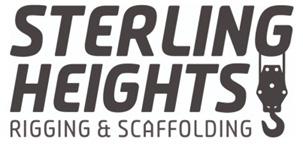
Tahuri Made are a small Pakihi Māori (māori business) located in Whakatāne, the sunshine capital of Aotearoa New Zealand.
“Our ambition is to produce high-quality and affordable products, infused with cultural and indigenous designs. Core products offered by Tahuri Made: Kakahu Māori, Pōtae, Jewellery, Homeware”.
Sterling Heights specialise in Advanced Rigging Rigging & Scaffolding, highly experienced in complex lifting and scaffolding. Focused on risk management, efficiency achieving excellence for our customers and training the next generation of Riggers and Scaffolders.
Core products and services offered by Sterling Heights Rigging Ltd:
• Rigging
• Scaffolding
• Steel Erection
• Controlled Demolition
• Salvage
• Temporary Fencing

“The aim of my mahi is to make Māori art Illustrations more mainstream and affordable, and from that, bring more Māori culture into homes”.
Explore an extensive collection of exquisite and distinctive artworks crafted by
Vendela Illustrations:
• Art Prints
• Canvas Art
• Original Ink Art
• Commission Art
Our database directory creates a convenient one-stop platform for internal/external stakeholders and whānau wishing to support Ngāti Awa pakihi. It also provides exposure for our pakihi and allows them to connect with likeminded business owners. Te Rūnanga O Ngāti Awa specifically utilise this directory for products and/or services that we may need. Within this past year we have used and supported many of our pakihi through various trainings and events such as the Matariki Whakapiri. If you would like to register your pakihi to this database, this can be done through our website or alternatively you can contact pakihi@ngatiawa.iwi.nz to enquire further.
If you are interested in learning more about any of the pakihi or would like to know what other pakihi are featured, be sure to visit the Pakihi Ngāti Awa Database. This database will help us to continue developing the Ngāti Awa economy and supporting Ngāti Awa business owners.

Tumuaki
Mark Harawira
Tumuaki Tuarua
Tuwhakairiora O’Brien (elected as Tumuaki 17.02.23)
Manurere Glen (elected 17.02.23)
Manahautū
Reuben Araroa
General Manager, People & Capabilities
Romana Graham
General Manager, Policies & Strategy
Bev Hughes
Pou Kokiri
Mike Panapa
Executive Assistant to the Manahautū
Haley McCorkindale
Receptionist
Te Awhina James
Peti Reneti
Rere Williams
Taini Hudson
Manager Identity, Language & Culture
Noti Belshaw
Manager Knowledge & Information
Jackeline Wharewera
Manager Taiao
Bev Hughes
General Manager, Te Mānuka Tutahi
Vaimanino Harawira
Manager, Projects Office
Krystal Legg
Kataraina Monika
Customary Fisheries Advisor
Charlie Bluett
Iwi Register
Monica Maniapoto
Information Technology/
Ngāti Awa Research & Archive
Ngaire Rapana
Malia Godsmark
Adrian Jaram
COMMUNICATIONS & ENGAGEMENT
Karla Akuhata
Maria Elliot
Rere Williams
TAIAO
Jolene George
Lynsey Mariu
KOREHĀHĀ WHAKAHAU
John Eruera
Rangipai Eruera
Naedene Stewart
Karla Akuhata
Merenia Sawrey
Simon Stokes
Greg Moorcroft
Dan Baigent
Simon Harris
Terina Mokomoko
Raynor Poutama
Kaia Vercoe
Damon Sturmey
Summer O’Sullivan
Kadyn Harawira
Sienna Walker
Thomas Monaghan
Tira Mokomoko
Genesis O’Sullivan
Jaymee Karekare
Te Herri Falwasser
KOREHĀHĀ RANGAHAU
Lanae Cable
Robert Whitbourne
Te Kawa Robb
TE AU O TE WAI
Gina Mohi-Helmbright
Lanae Cable
Dawn Hill
Davina Thompson
TAIHURINGA, PROJECTS MANAGEMENT
Kataraina Monika
Tawera Simpson-Rangi
Kriscina Kerr
Te Aurere Williams
Mania Crown
Courtney Reneti
Krystle Legg
Paige Wawatai
Te Aotaawhirangi Onehi
Te Awhina James
Anituatua Black
Melissa Weenink-Smith
Stephen Hutchings
Riki Burnett
Peti Reneti
TE MĀNUKA TŪTAHI MARAE
Pou Arataki / Ngā Kaimahi Tautoko
Kataraina Reneti-Panapa
Piripi Akuhata
Te Rau Wharangi Hudson
Watarawi Te Moana
Jessica Mules
TE TOKA TŪ HAUMARU
Vicki Murray
Sharon Tutua
Sharlene Kingi
Georgina Maxwell
Keita Wharewera
Kataraina Reneti
Pare Pouwhare-Akuhata
Rere Williams
Peti Reneti
Chairman
Paul Quinn
Jim Mather (appointed)
Chief Executive Officer
Tracey Hook
Board Secretary/Executive Assistant to the CEO
Courtney Reneti
Akino Smith
Group Financial Controller
Stuart Brown
Finance
Lynsey Mariu
Dylan Stewart
Luana Morgan
Operations
Alieta Waitoa
Romana Graham
Gerard Jull
Stevie Ransfield
Patrick Wetini
Ngāti Awa Tourism Limited
Patrick O’Sullivan
Jennifer Goodfellow
Sea Operations Skipper
Paul Kingi
Farm Manager Ngāti Awa Heritage Estate
Sam Philps
Contract Milker Ngakauroa Farm
Mike Learmond
Contract Milker Tumurau Farm
Craig Spence



Freephone: 0800 464 284
Telephone: +64 7 307 0760
Email: runanga@ngatiawa.iwi.nz
www.ngatiawa.iwi.nz